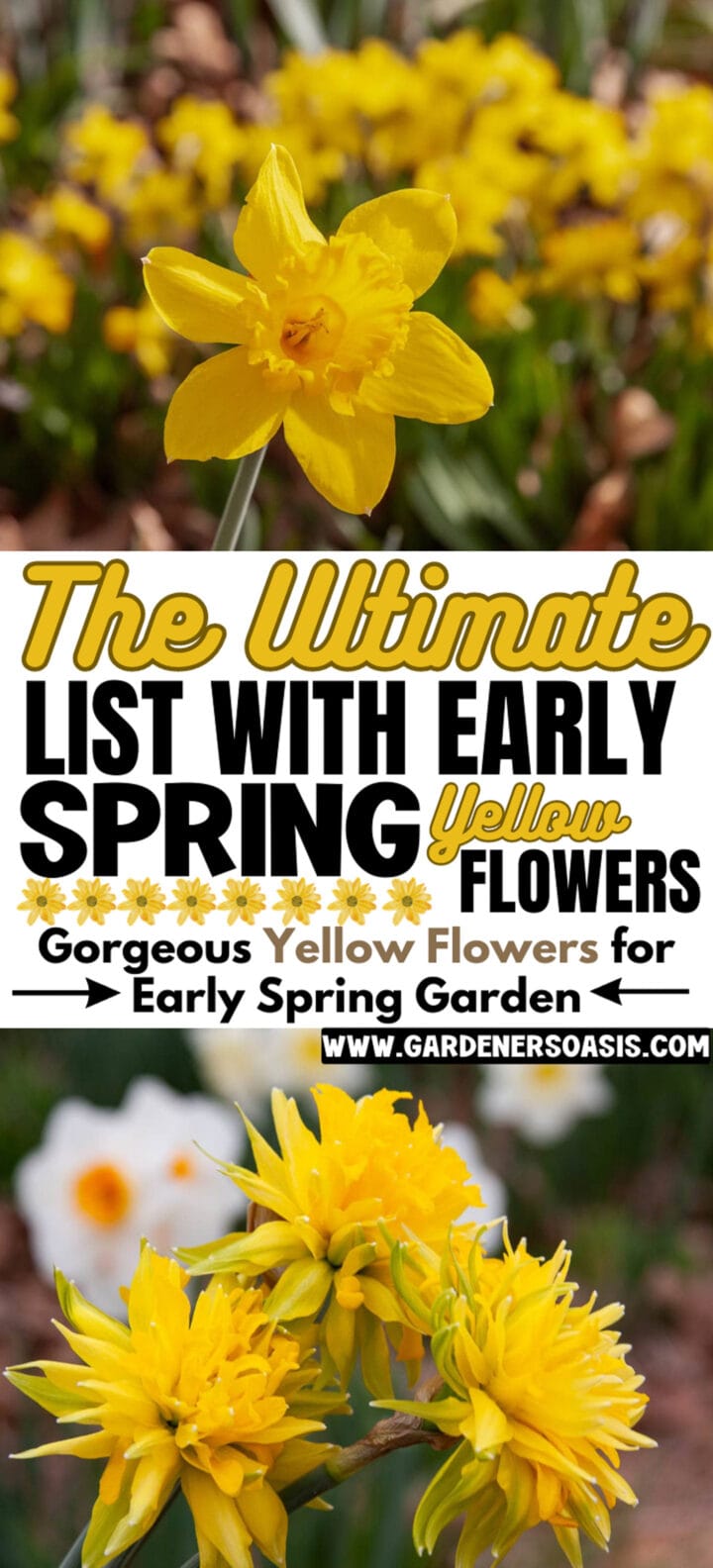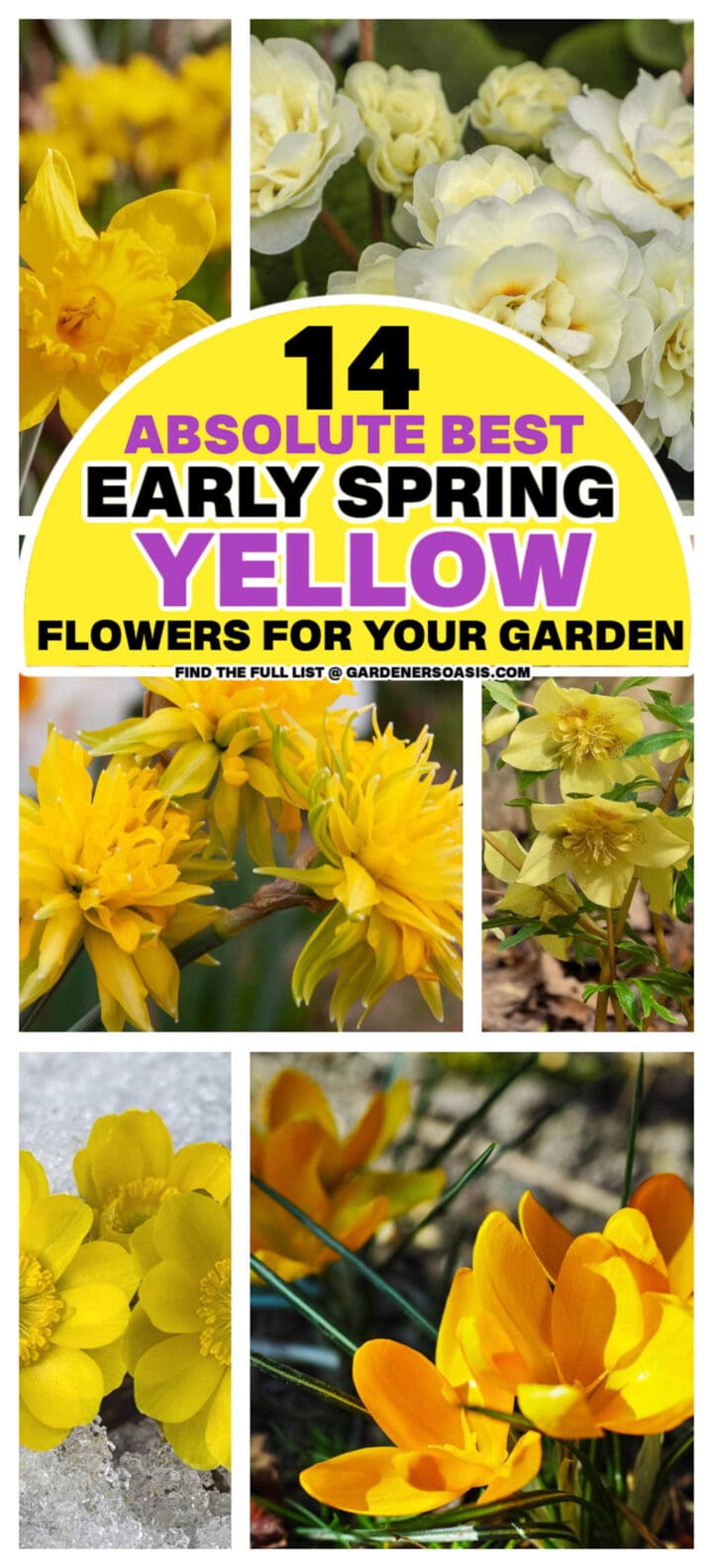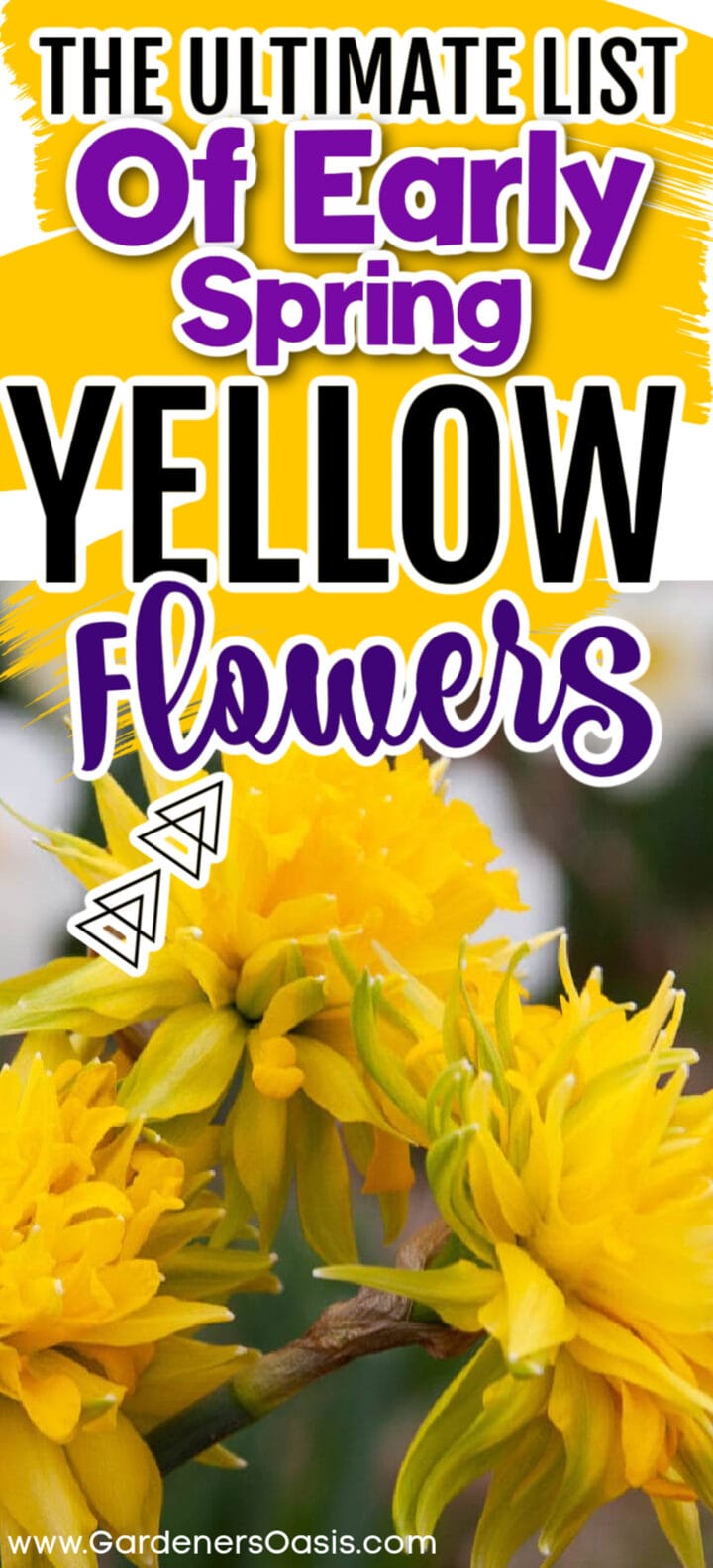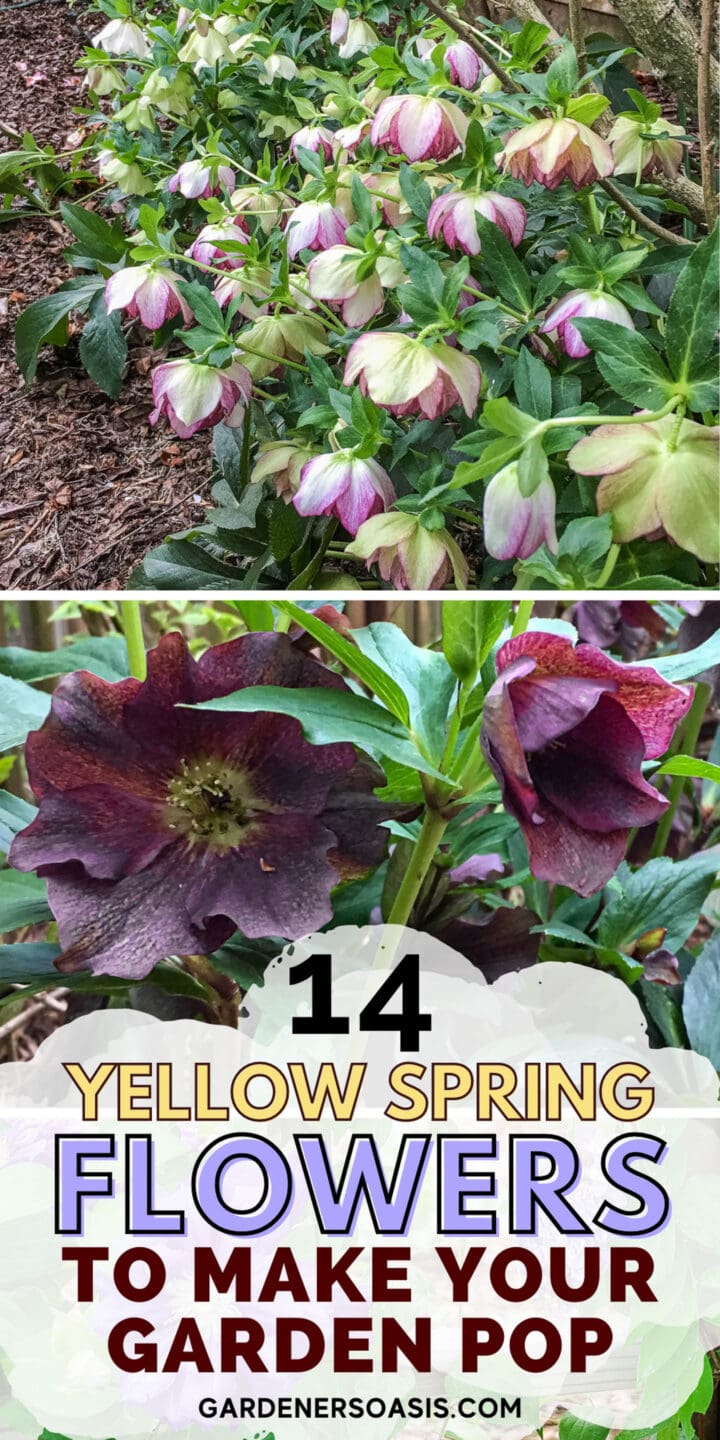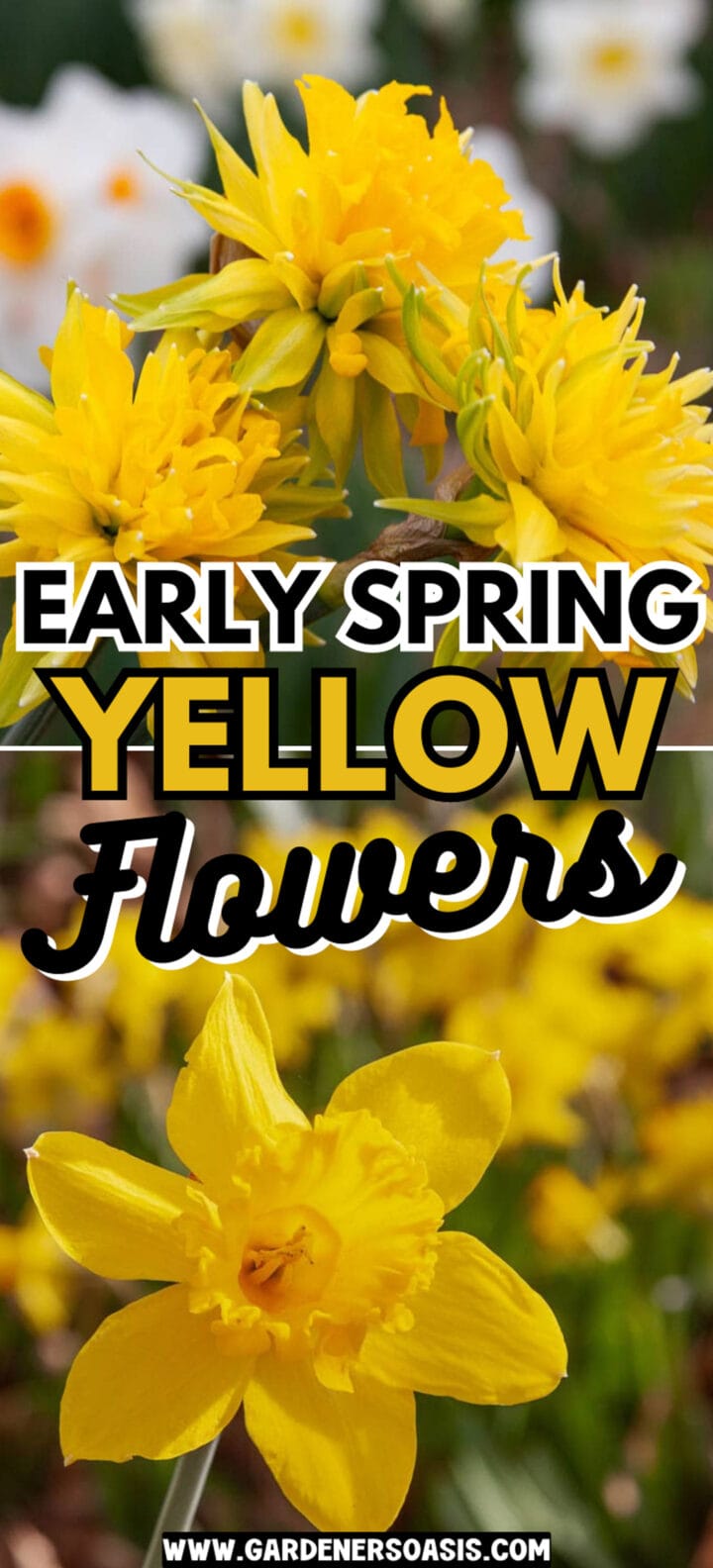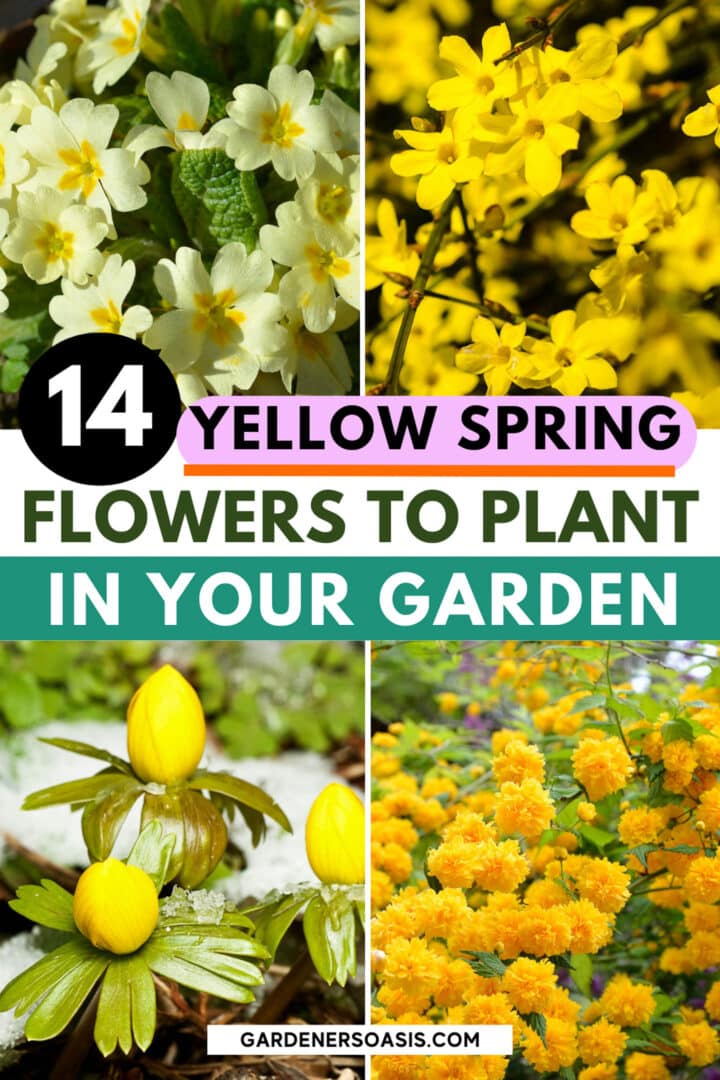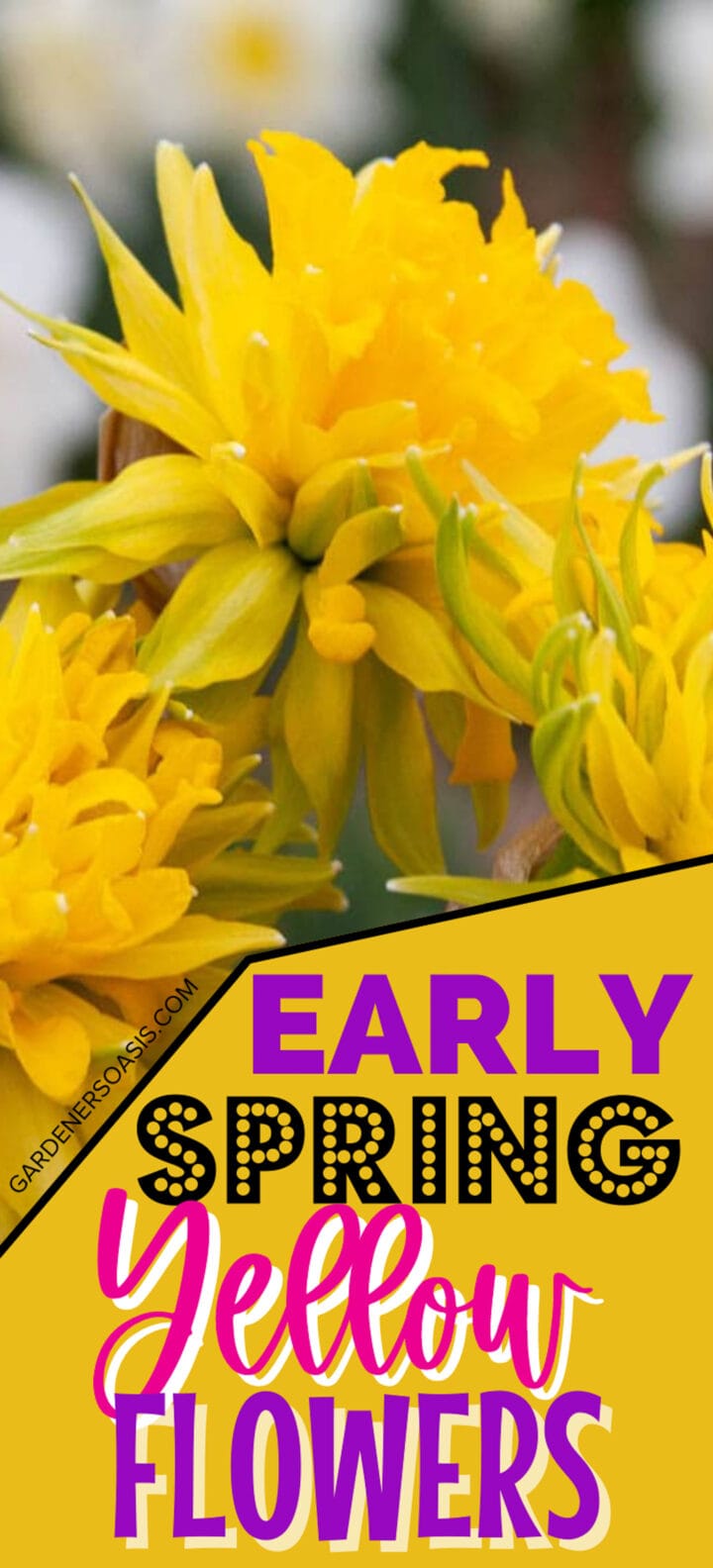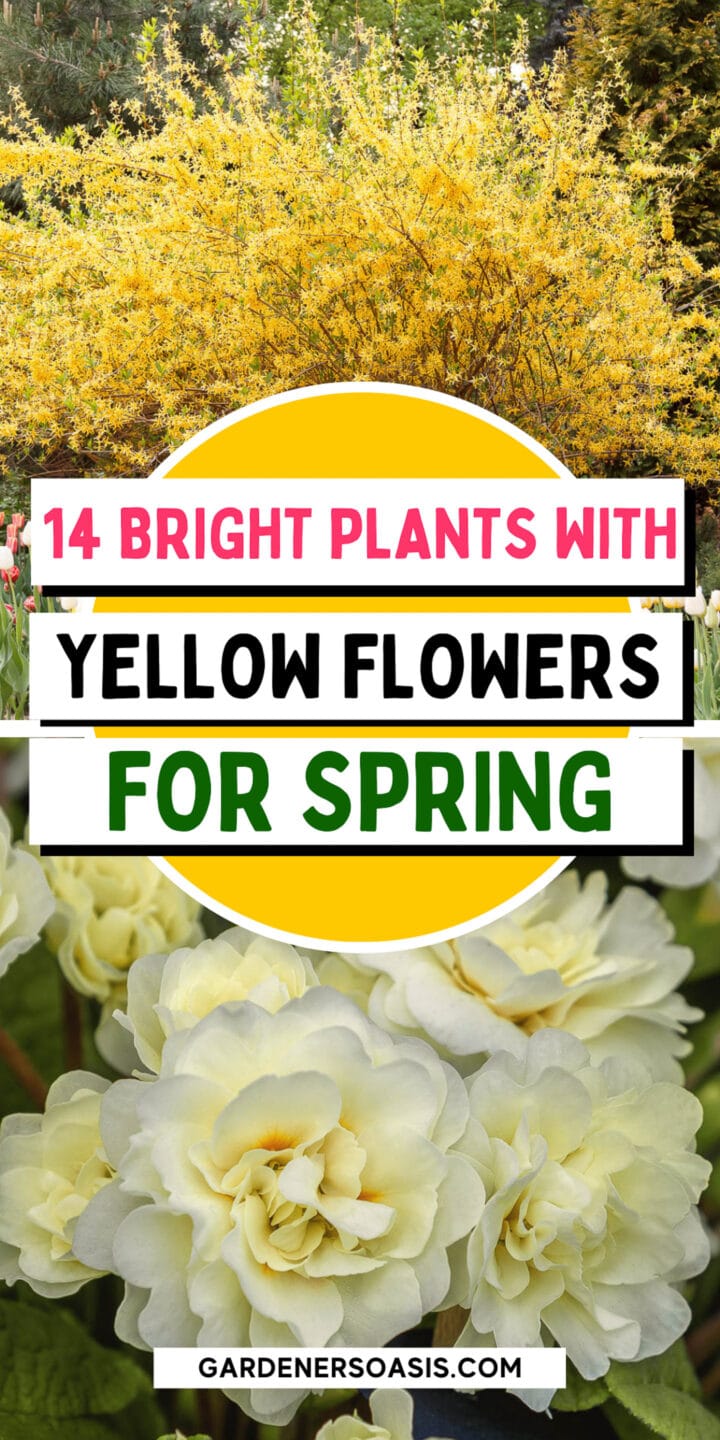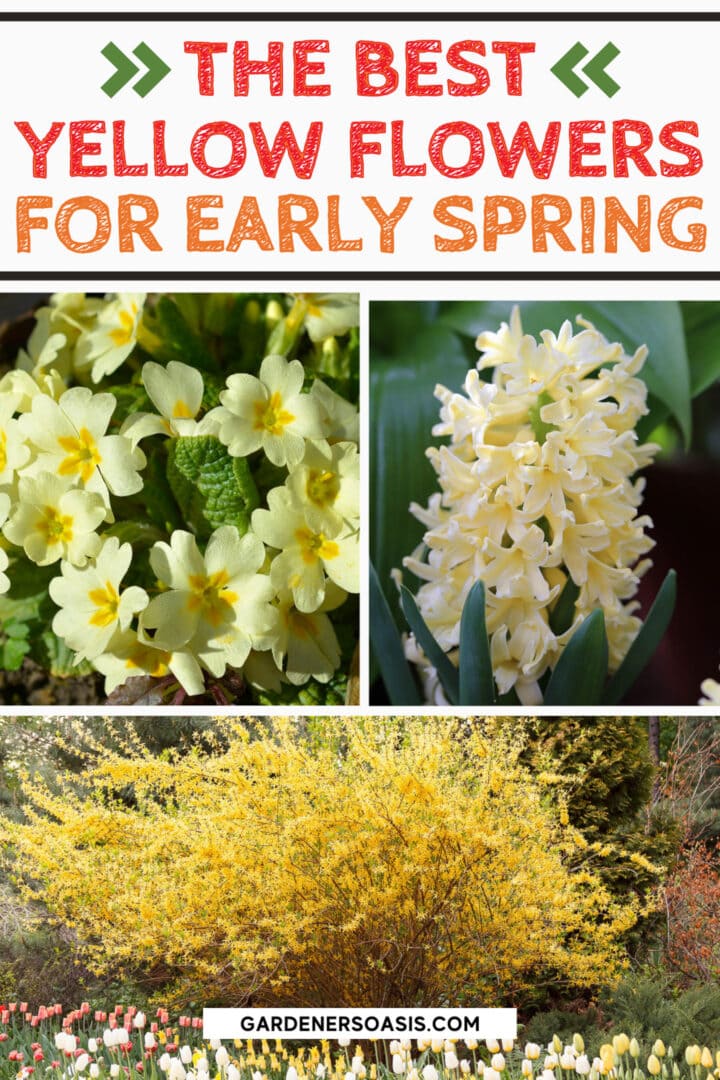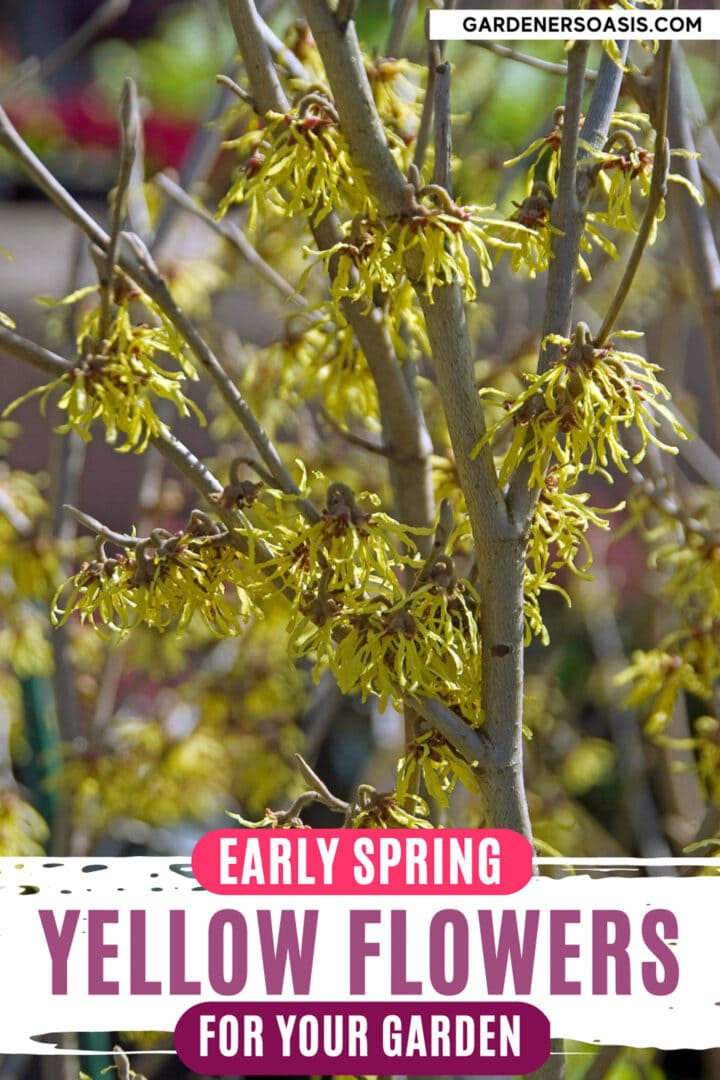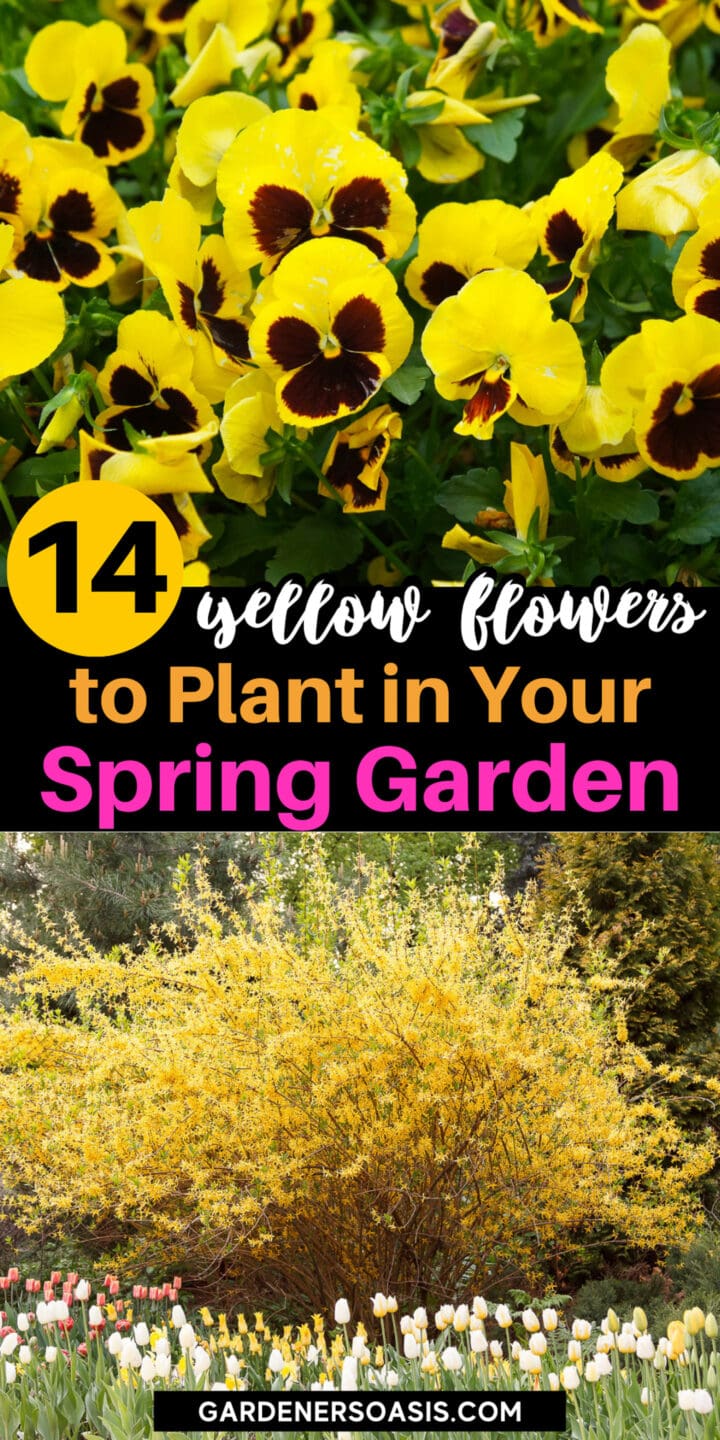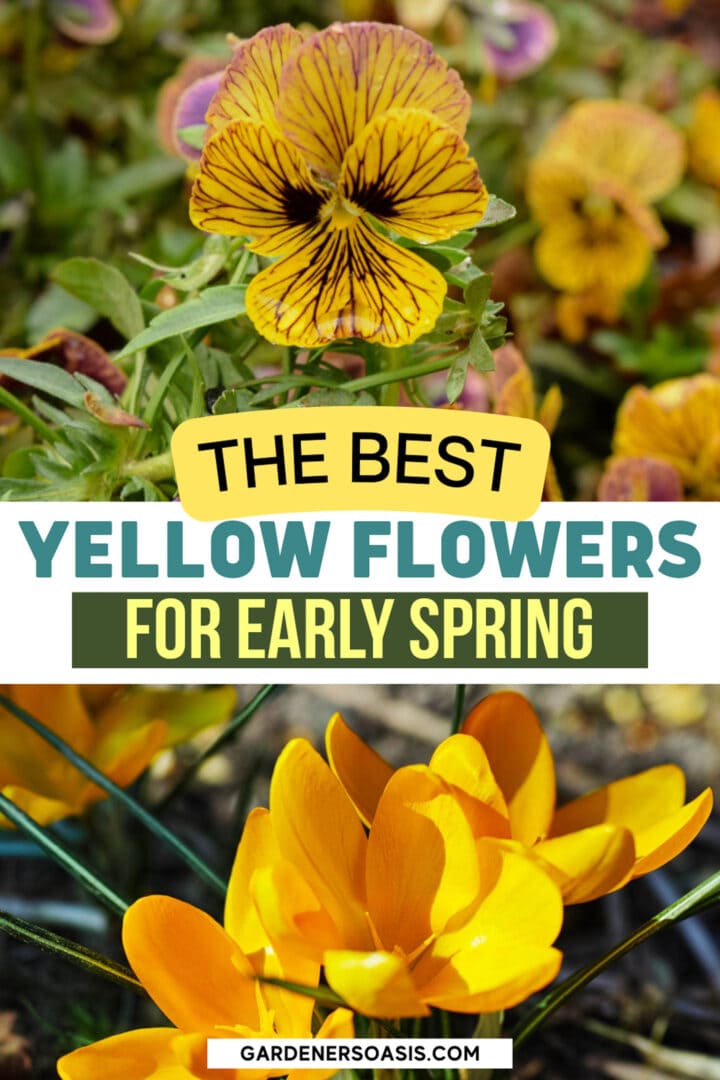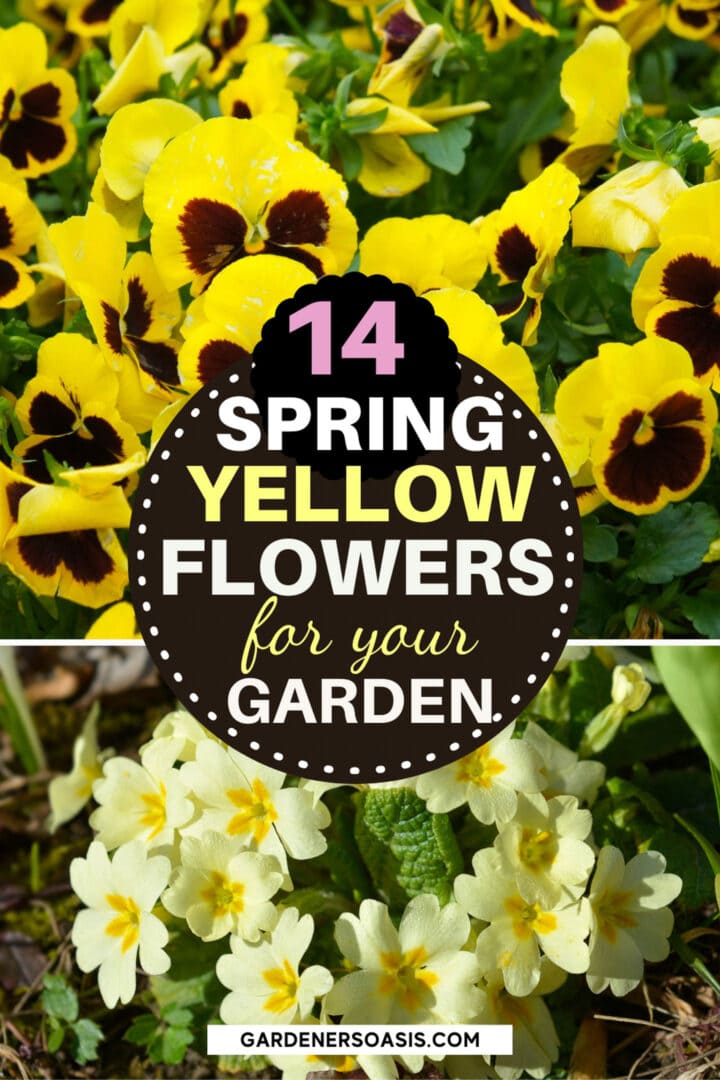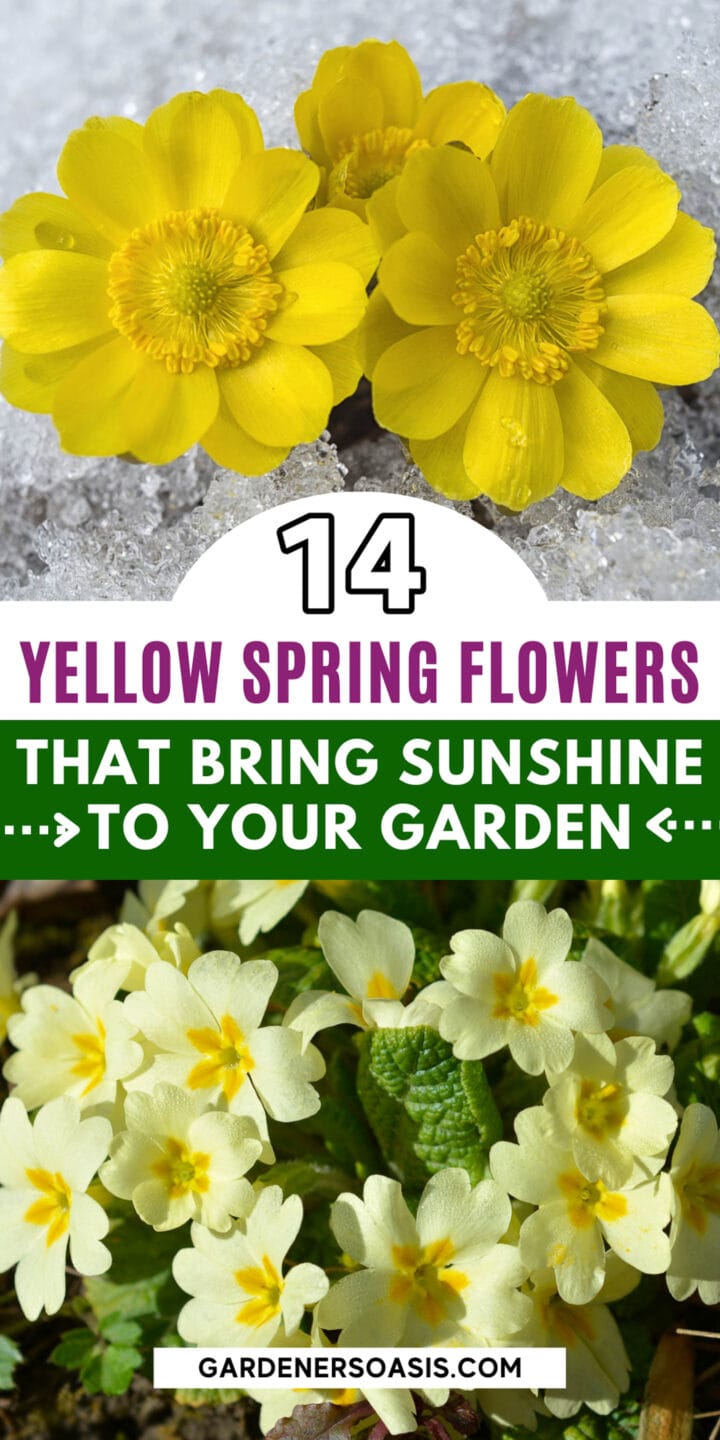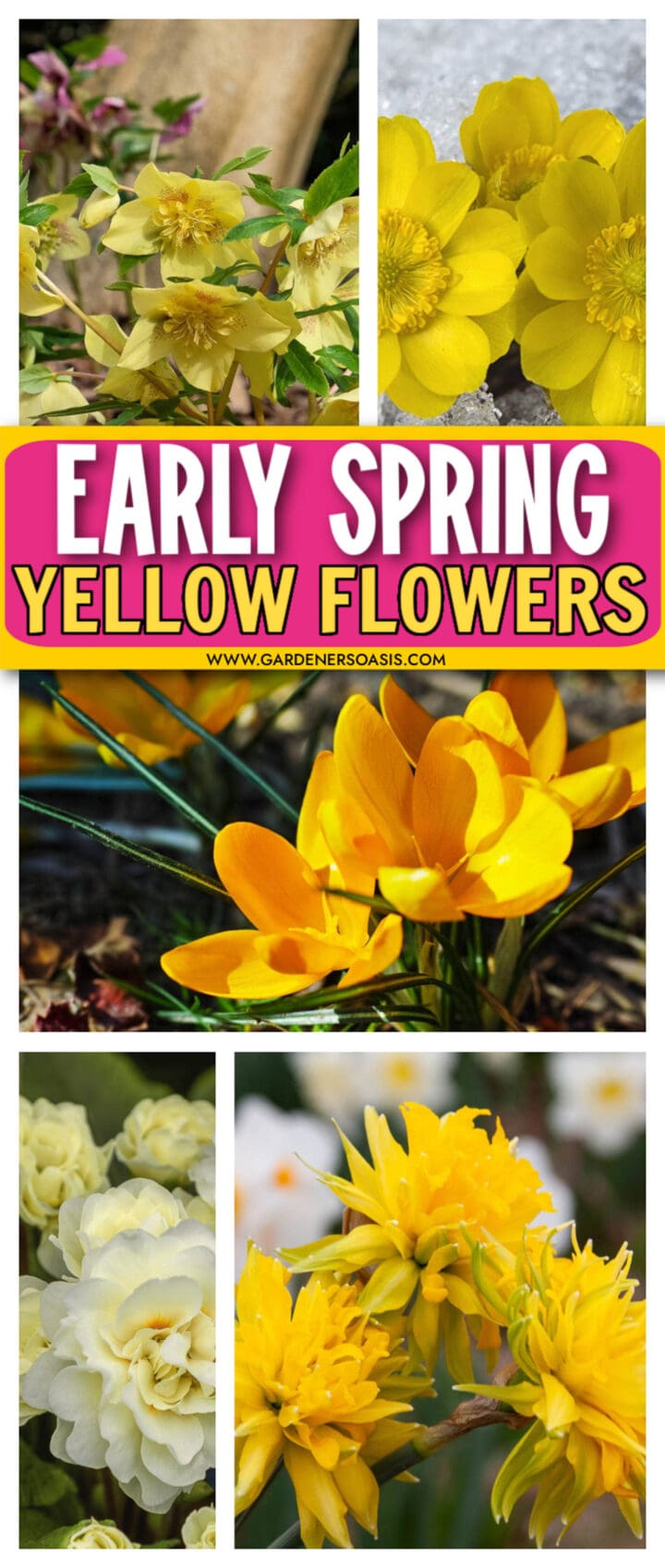Early Spring Yellow Flowers
These early spring yellow flowers are often the first plants to indicate that winter is over. Some on this list, like forsythia and daffodils, you will likely know and look for each year. Others will introduce you to something new and different but equally as stunning.
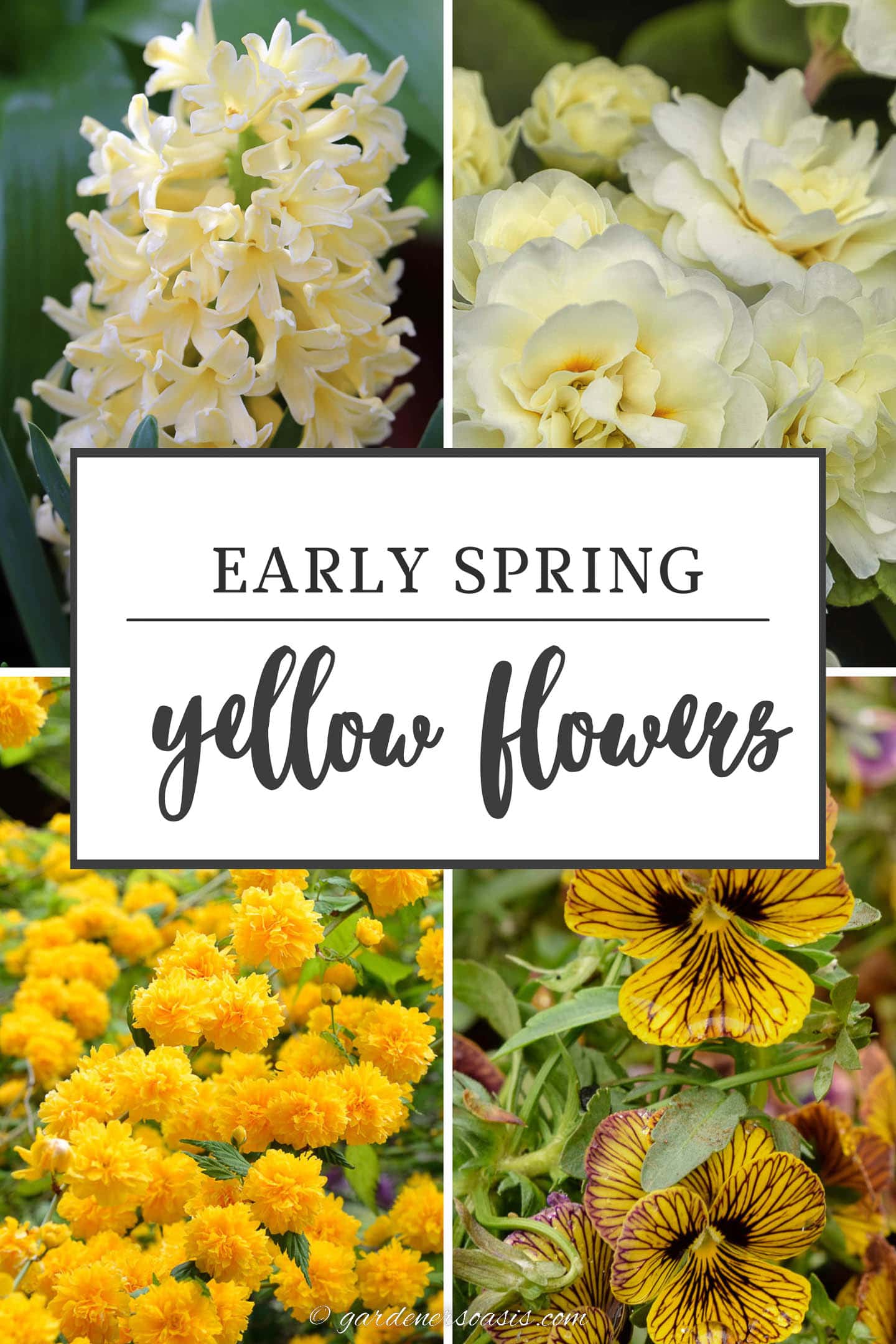
In my books, yellow flowers that bloom early in the spring are the perfect way to signify that winter is almost over.
They remind me of the sun, lift my spirits and their bright color adds joy to the garden at a time when it really needs some.
And I think I’m not the only gardener who believes this since there are so many choices!
There are bulbs on the list that need to be planted in the previous fall as well as perennials, shrubs and even vines.
Some are fragrant, evergreen, or go dormant in the heat of summer.
So if you like yellow flowers and want to see them early in the year, I think you will find a welcome addition to your landscape here.
1 | Daffodils
Daffodils are one of the most recognizable early spring yellow flowers. And I think every garden needs some!
Here are a couple of my favorite varieties.
a) Rip van Winkle daffodil
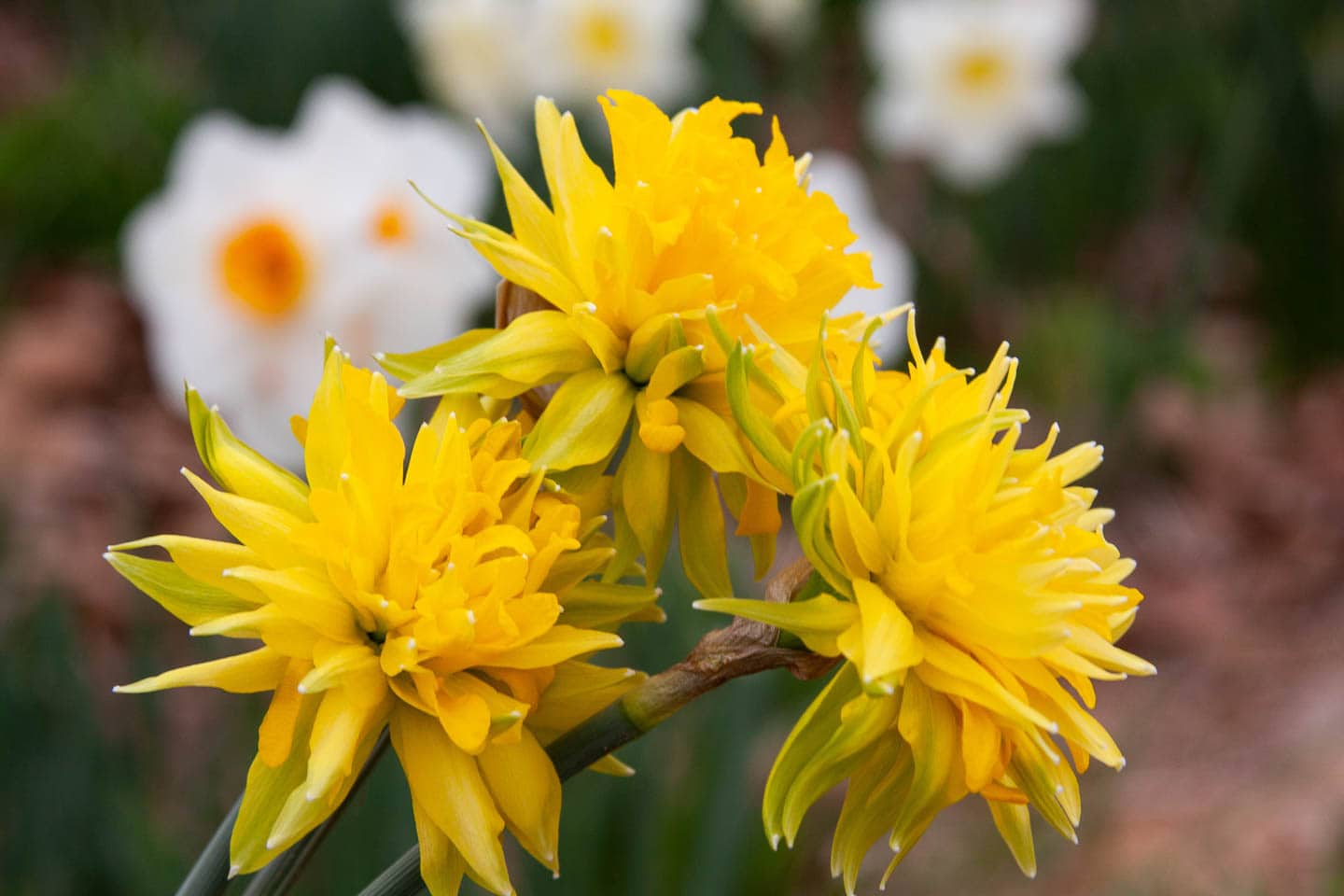
Scientific name: Narcissus ‘Rip van Winkle’
Zone: 3 to 9
Exposure: sun, part shade
Height: 6″
Width: 4″
Bloom time: early spring
Flower color: yellow
Rip van Winkle is a miniature daffodil variety that is one of the earliest spring bloomers.
The long lasting multi petaled 2″ wide blooms make a cheerful statement in the front of the border.
Plant the bulbs in the fall in well-drained soil about 4-6″ apart. (They look best if planted en masse). Then water in and mulch.
After it has stopped blooming, the strappy green foliage should be allowed to die down naturally in the spring. But I do cut off the flower stalks after the blooms are spent to make the plant look neater.
It naturalizes well and resists deer.
b) Yellow Trumpet daffodil
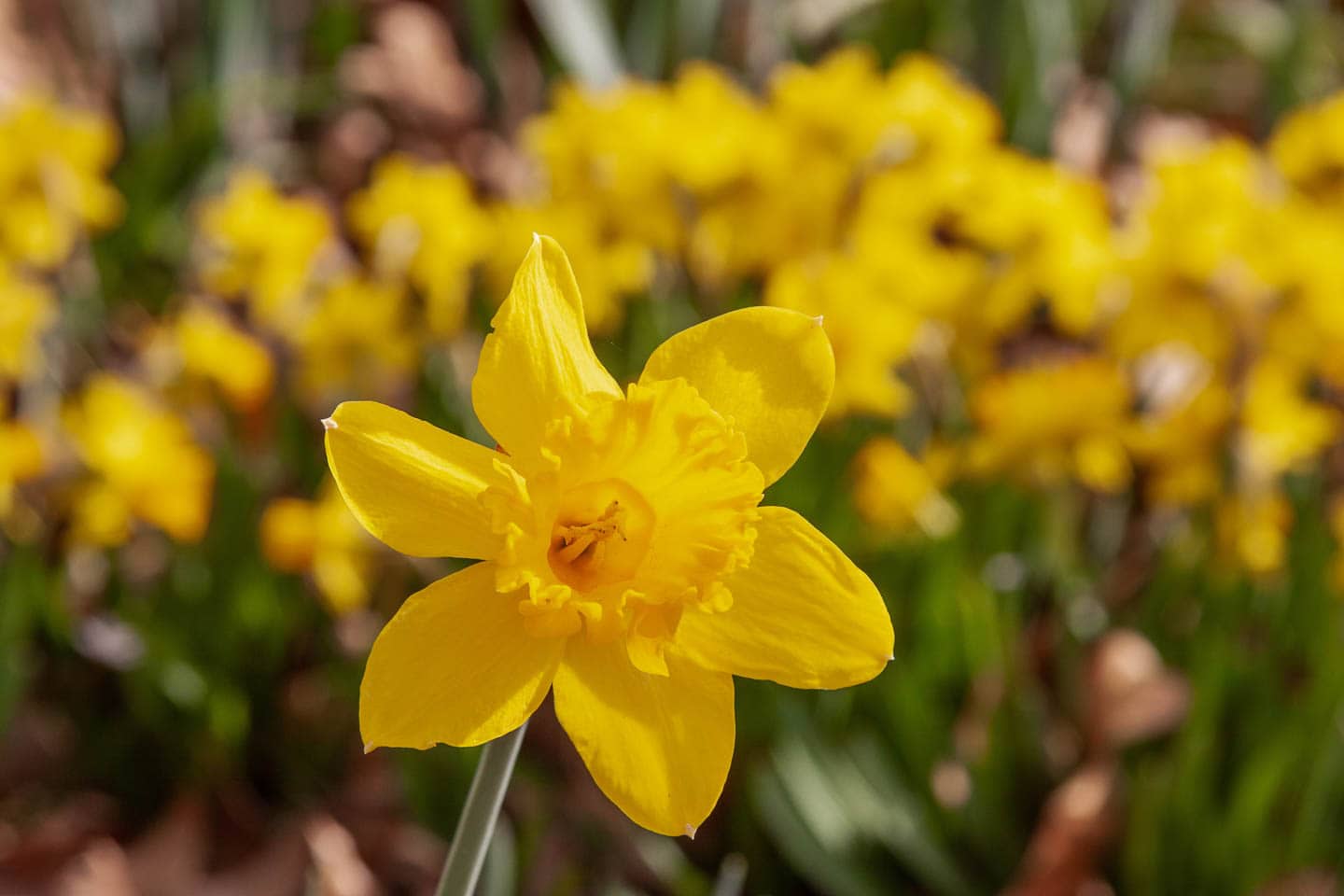
Scientific name: Narcissus pseudonarcissus
Zone: 3 to 9
Exposure: sun, part shade
Height: 16″ to 18″
Width: 7″
Bloom time: early spring
Flower color: yellow
The yellow trumpet daffodils definitely announce the arrival of spring.
These vigorous growers can be planted anywhere you want to see their bright yellow 4″ cheerful trumpet-shaped flowers.
Plant these deer-resistant bulbs 6″ deep and 4″ to 6″ apart in well-drained soil.
Mulch in colder climates.
After the flowers are finished, let the foliage die naturally, but dead-head the spent flower stalks.
Trumpet daffodils readily naturalize under bushes or in the lawn.
2 | Giant Yellow Crocus
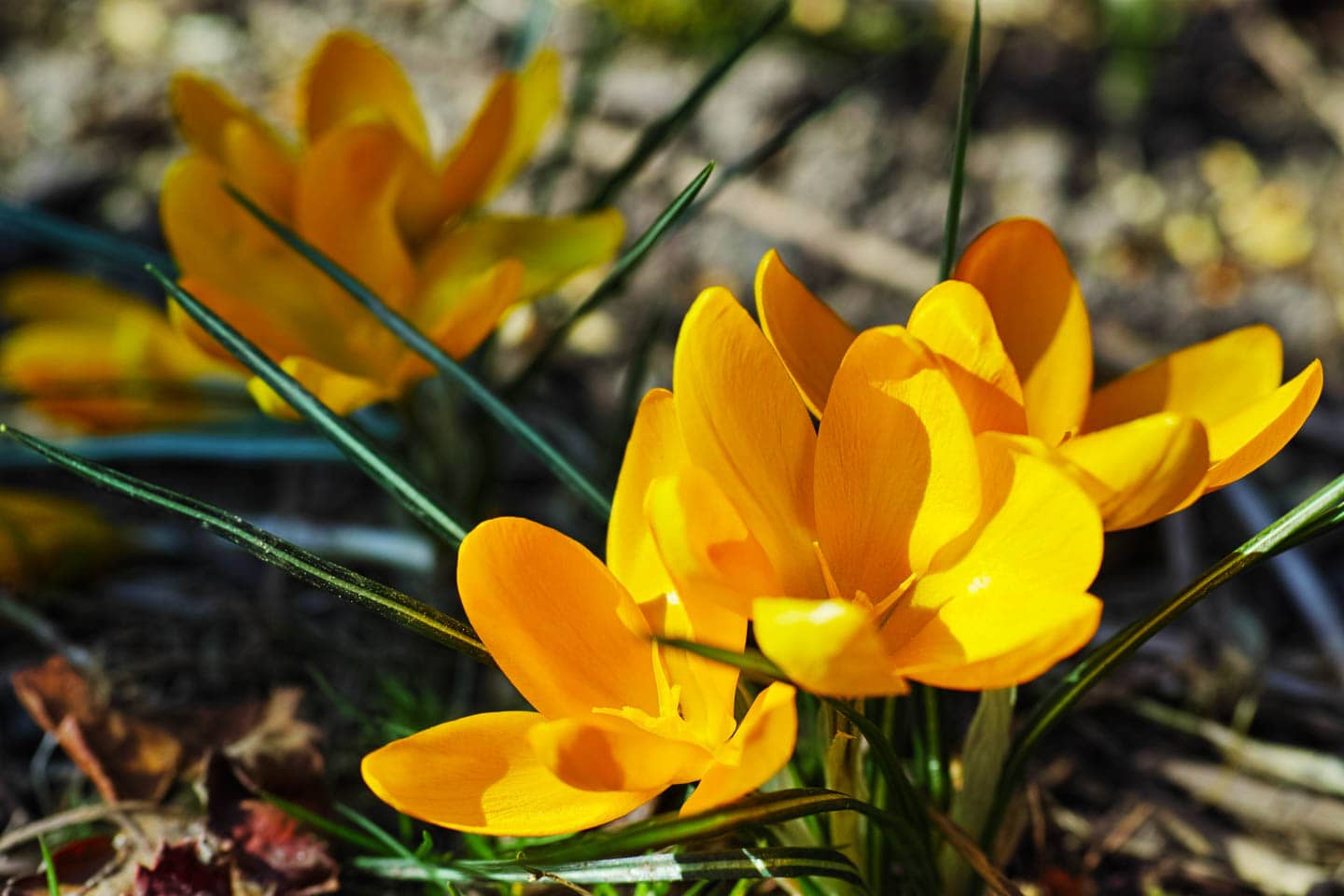
Scientific name: Crocus x luteus
Zone: 3 to 8
Exposure: full sun, partial shade
Height: 3″ to 6″
Width: 4″ to 6″
Bloom time: early spring
Flower color: golden yellow
You know the dull days of winter are receding when you spy the sunny, glorious, gigantic blooms of the yellow crocus.
The flowers will dwarf the spike like green foliage.
In order to enjoy this late winter, early spring vista, plant the corms in well draining soil, in the fall at a density of 8 to 10 bulbs per square foot.
It is easiest to dig a wide hole about 5 inches deep, mix 2 inches of compost into the bottom, then drop in the corms with the pointy end down.
Water well and back fill with soil. Cover with mulch or leaves. They do not need to be watered more than that.
Crocuses naturalize rapidly, are deer resistant, and are magnets for pollinators.
3 | Winter Aconite
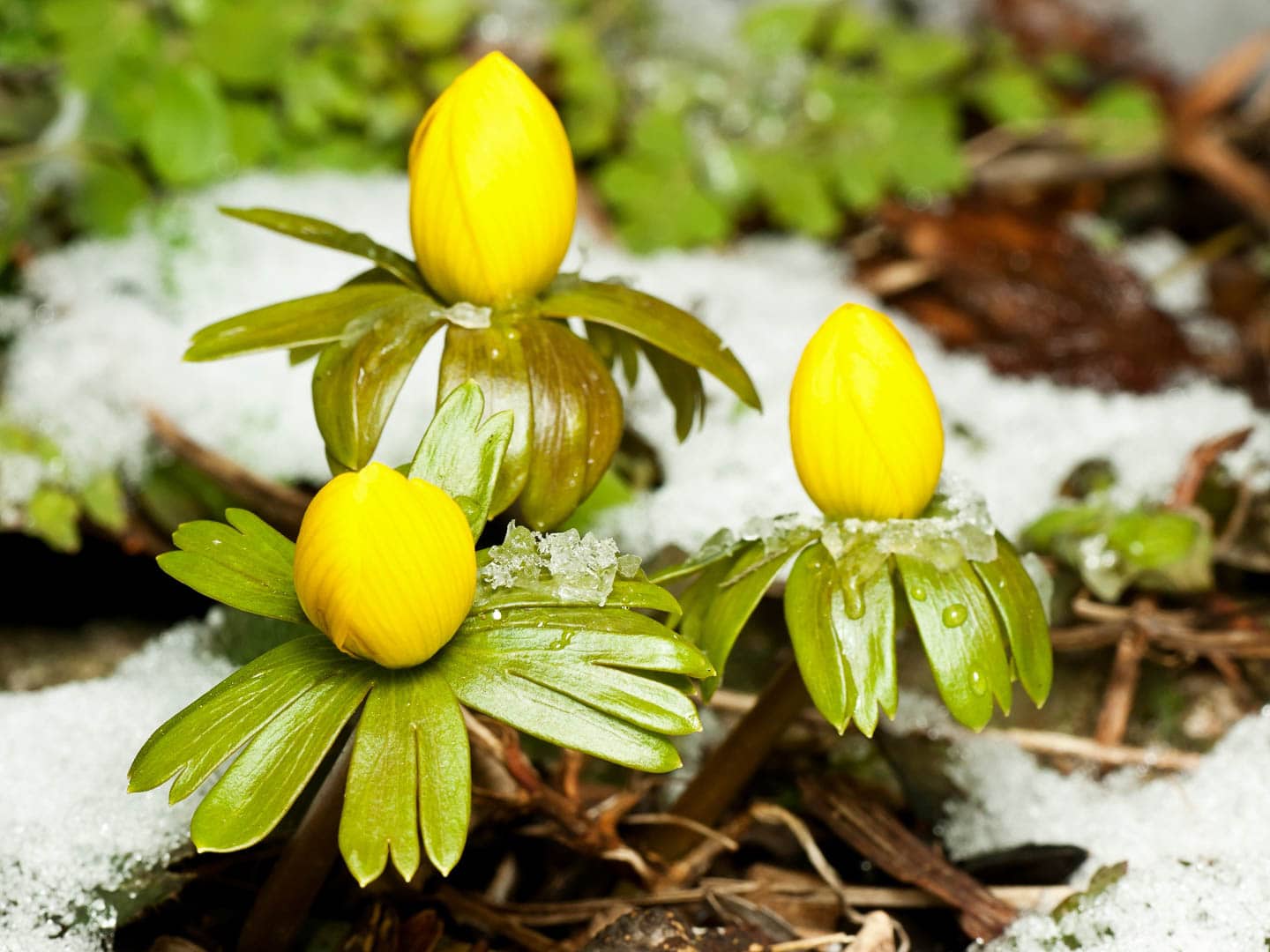
Scientific name: Eranthus hyemalis
Zone: 3 to 7
Exposure: winter sun, then partial to full shade
Height: 3″ to 4″
Width: 4″
Bloom time: late winter
Flower color: buttercup yellow
Whereas, crocuses are well-known and recognized, winter aconite is an underutilized plant, perhaps because it is difficult to get established in the garden.
The buttercup shaped flowers, which bloom earlier than crocuses, are small (1″ in diameter) surrounded by a lobed blue-green ruff of foliage. When the flowers fade, the foliage remains until it also dies back.
They are native to Europe woodland areas so need humous rich soil.
These tubers do well where they will get full sun to bloom but shade after the blooms die. So they are perfect to plant under deciduous trees, where they bloom before the leaves come out.
Soak the tubers overnight before planting 5″ deep and about 6″ apart in odd number groups.
Winter aconite looks most impressive when planted in drifts where they will not be disturbed. They will self seed as well as naturalize once established.
It does not like to dry out and needs regular watering all year.
Winter aconite has good rodent and deer resistance. And it will grow under black walnut trees where very few other plants can survive.
All parts of this plant are poisonous to humans.
4 | Yellow Dutch Hyacinth ‘City of Haarlem’
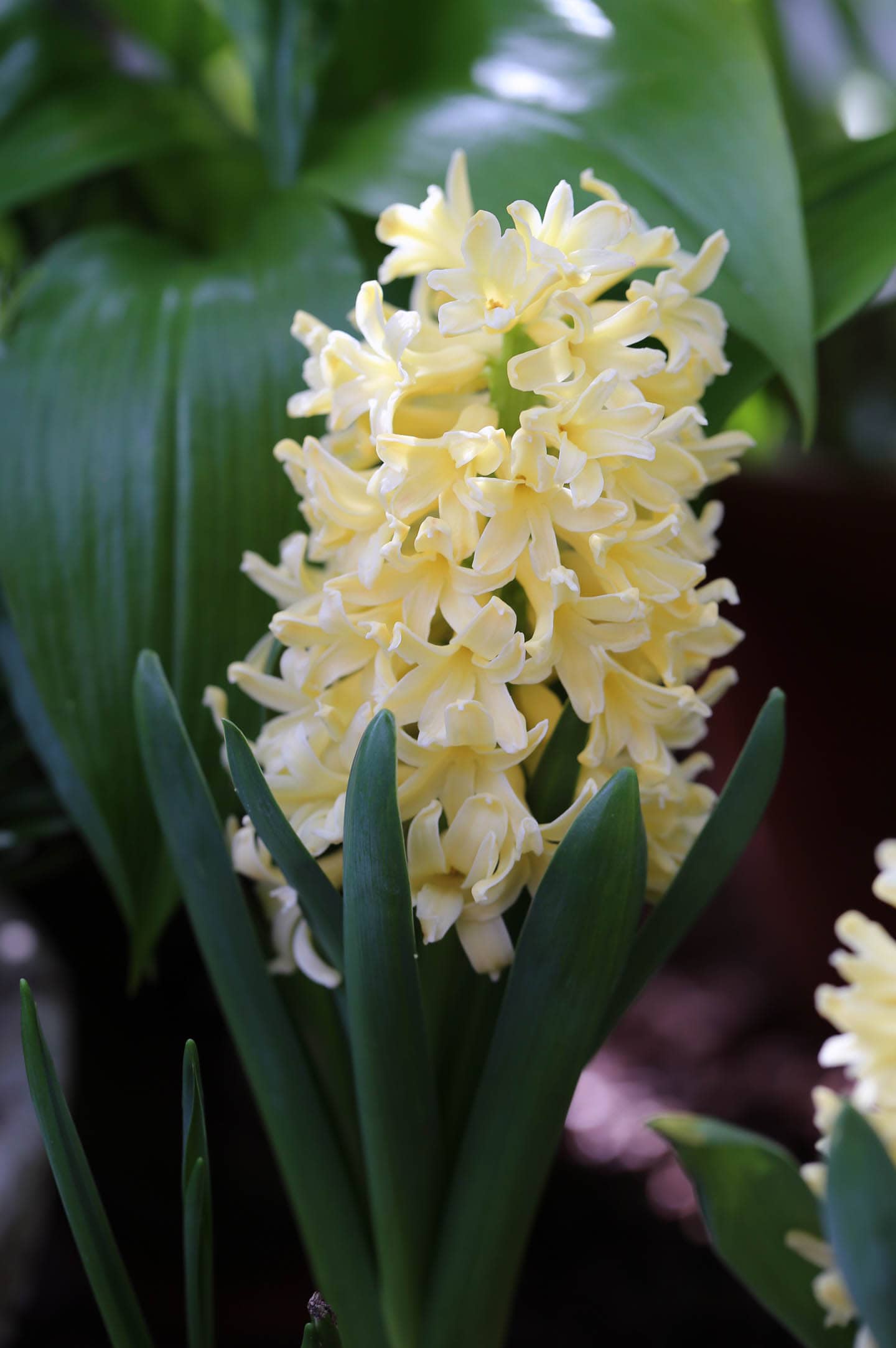
Scientific name: Hyacinthus orientalis ‘City of Haarlem’
Zone: 4 to 8
Exposure: full sun, partial shade
Height: 8″ to 10″
Width: 4″ to 6″
Bloom time: mid spring
Flower color: soft primrose yellow
City of Haaelem hyacinth is an intensely fragrant welcome addition to the spring border.
Densely packed florets form a sturdy tubular flower spike that deer avoid.
The bulbs should be planted in the fall by:
- loosening the soil to 10″,
- mixing in organic matter and/or bone meal,
- planting the bulbs 6″ deep and 4″ – 6″ apart, then
- watering well.
After they have finished blooming, cut off spent flower spikes but let the curved green linear foliage die back naturally. This will allow the bulbs to get renewed for next year’s growth.
5 | Hellebore or Lenton rose
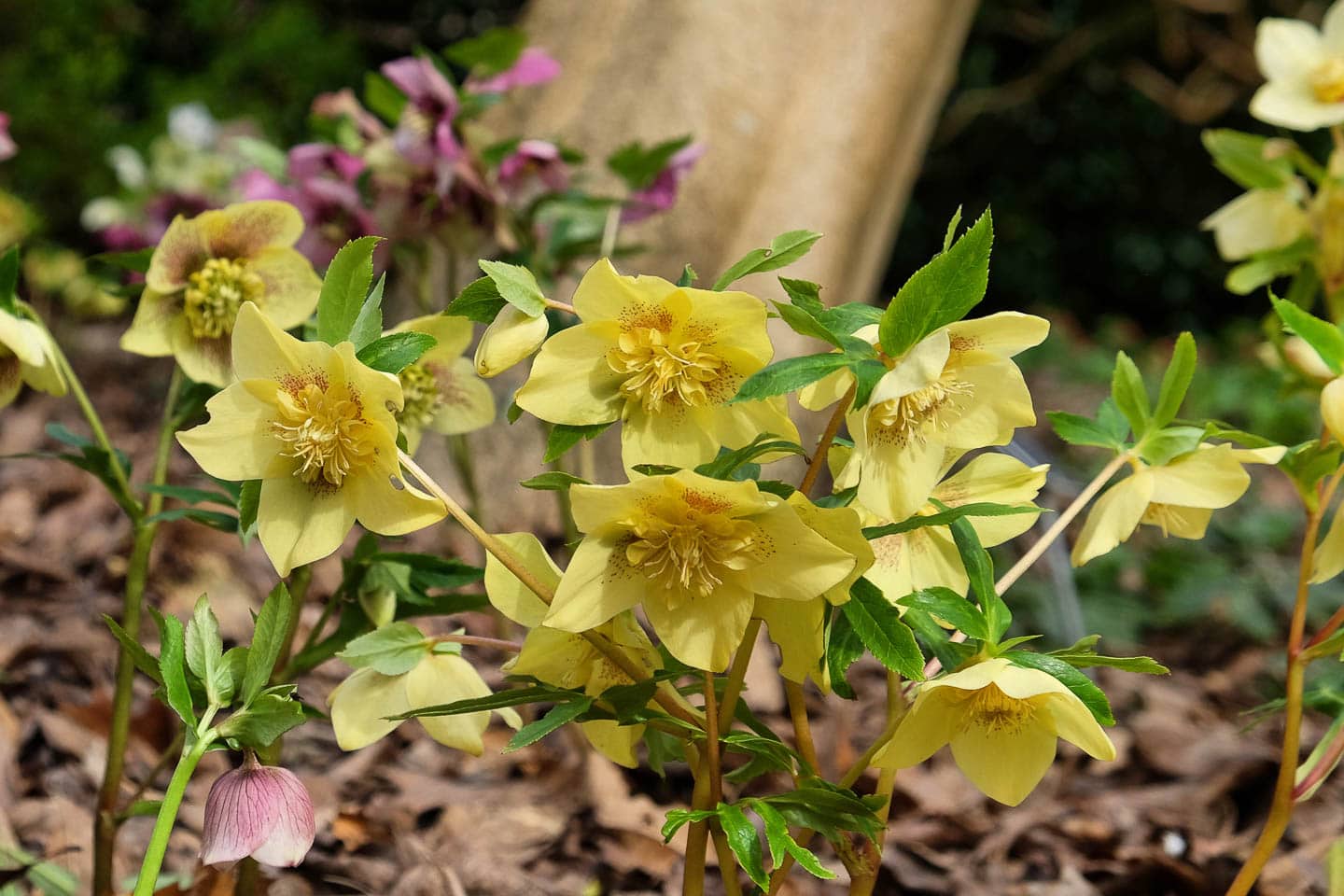
Scientific name: Helleborus
Zone: 4 to 9
Exposure: part shade to full shade
Height: 18″ to 24″
Width: 18″ to 24″
Bloom time: late winter to early spring
Flower color: bright yellow with maroon markings
Hellebores are evergreen plants producing many blossoms in late winter that last more than 6 weeks.
These perennials come in many colors including yellow.
‘First dance’ is a stunning, bright yellow double cultivar with maroon veining and picotee edging in the Wedding series. The blooms are 2-2 1/2 inches across.
‘Spanish flare,’ also developed by Hans Hanson, is part of the Honeymoon series. It sports single yellow flowers with maroon centers.
Both are very hardy, with sturdy stems.
Plant in average well-drained soil and water in. They need regular watering during dry spells.
They are deer and rabbit resistant but attract bees.
A low maintenance plant, Hellebores do not like to be disturbed once they are established.
6 | Amur adonis or pheasant’s eye
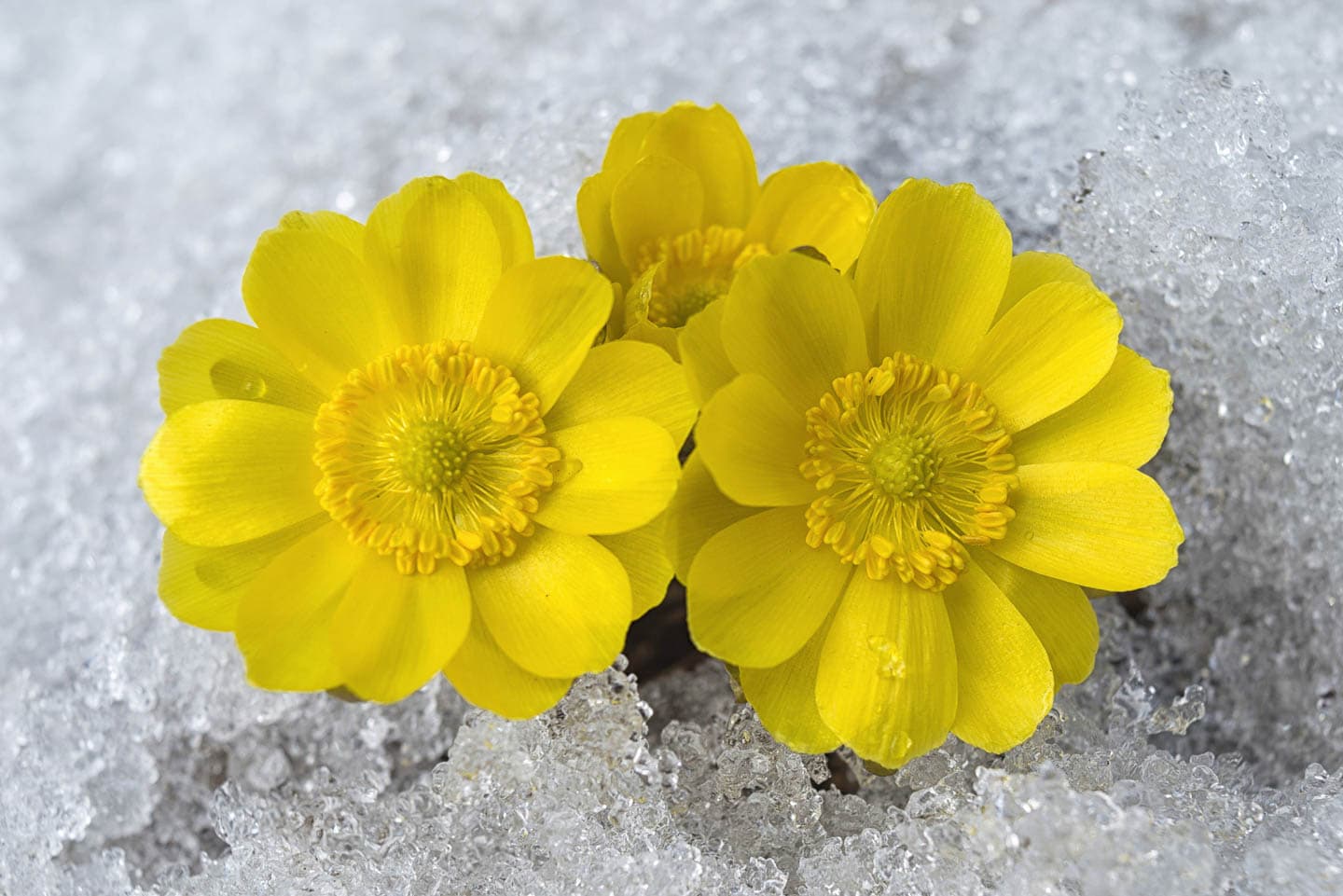
Scientific name: Adonis amurensis
Zone: 3 to 7
Exposure: part to nearly full sun
Height: 6″ to 12″
Width: 12″
Bloom time: late winter, early spring
Flower color: yellow
Adonis is a lovely plant that blooms with the early hellebores and snowdrops — a cheerful bright addition to the bleak late winter landscape.
Yellow gold 1″ wide anemone-like flowers precede the attractive dark fern-like foliage.
This rhizome needs moist well drained humous rich acidic soil.
It does well in a cool woodland setting where it blooms before the trees get their foliage.
The plants go dormant shortly after they have finished blooming so mark the spot for future reference.
They attract butterflies and resist deer.
7 | Primrose
a) Belarina Cream Primrose
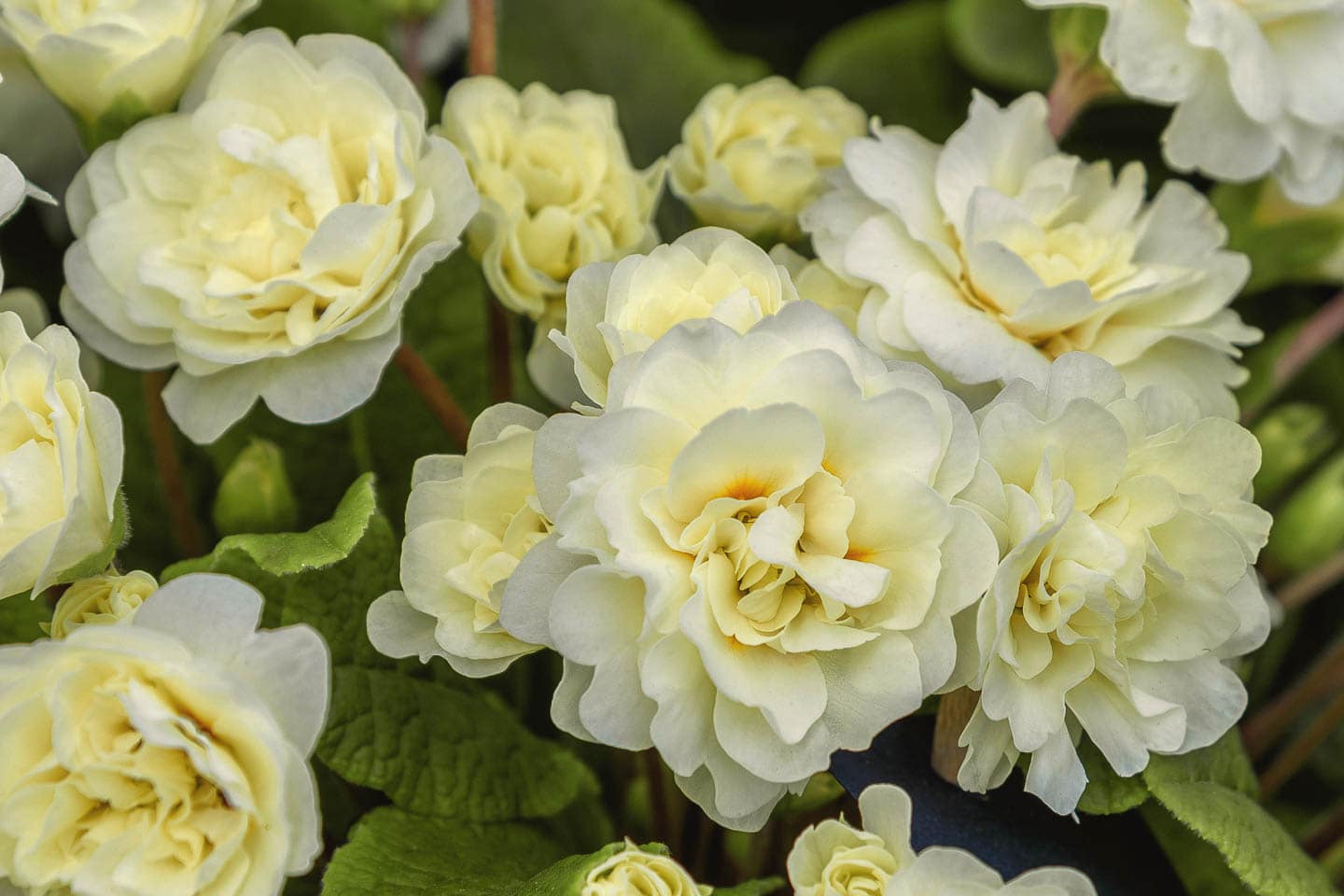
Scientific name: Primula ‘Belarina cream’
Zone: 4 to 7
Exposure: part sun
Height: 6″
Width: 6″
Bloom time: early spring
Flower color: pale yellow double
Another harbinger of spring is the Belarina® primrose series.
They come in an array of colors including a pale yellow (called ‘Cream’) and a brighter yellow (called ‘Buttercup’).
Primula are a cool weather woodland plant, so do well under trees and in the shaded border, plant 12 inches apart in humous rich, moist well drained soil.
They do not tolerate drought but do repel rabbits and deer though.
Their pollen in an important early source of food for the Duke of Burgundy butterfly.
These perennials are maintenance free except for the application of mulch in the fall.
b) English or common primrose
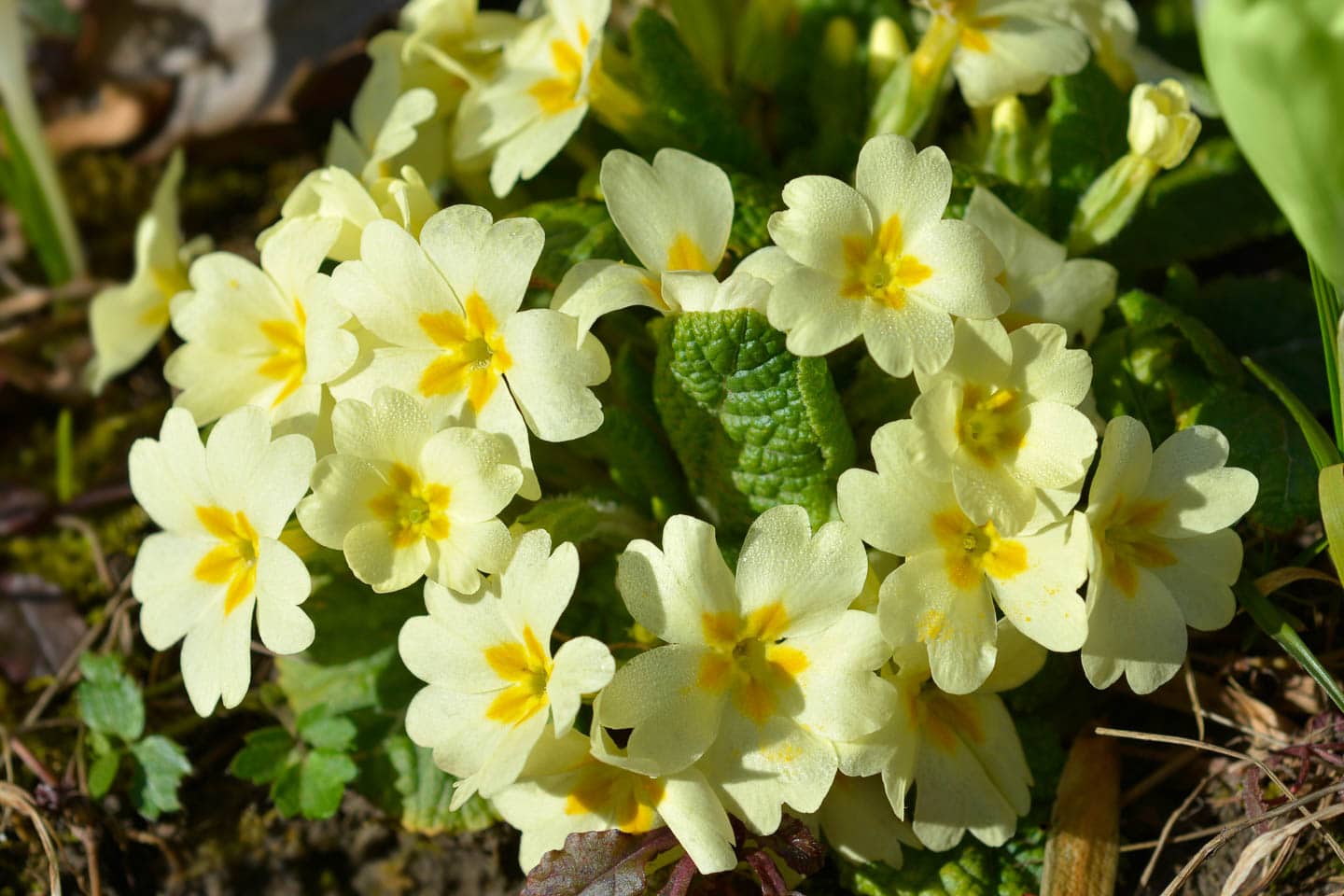
Scientific name: Primula vulgaris
Zone: 4 to 8
Exposure: part shade
Height: 8″
Width: 14″
Bloom time: early spring
Flower color: a variety of colors, pale yellow with darker centers is the most popular
Plant in consistently moist well-drained humus rich soil about 12″ apart in a shaded spot.
These are great companions for daffodils because they bloom at the same time.
The plants repel deer and rabbits but are also toxic to dogs, cats and horses.
The blooms form showy clusters of small 1″ flowers on a green leafed plant.
Propagate by division or allow to self seed and naturalize. Mulch with compost or manure annually.
c) Bumble Bee
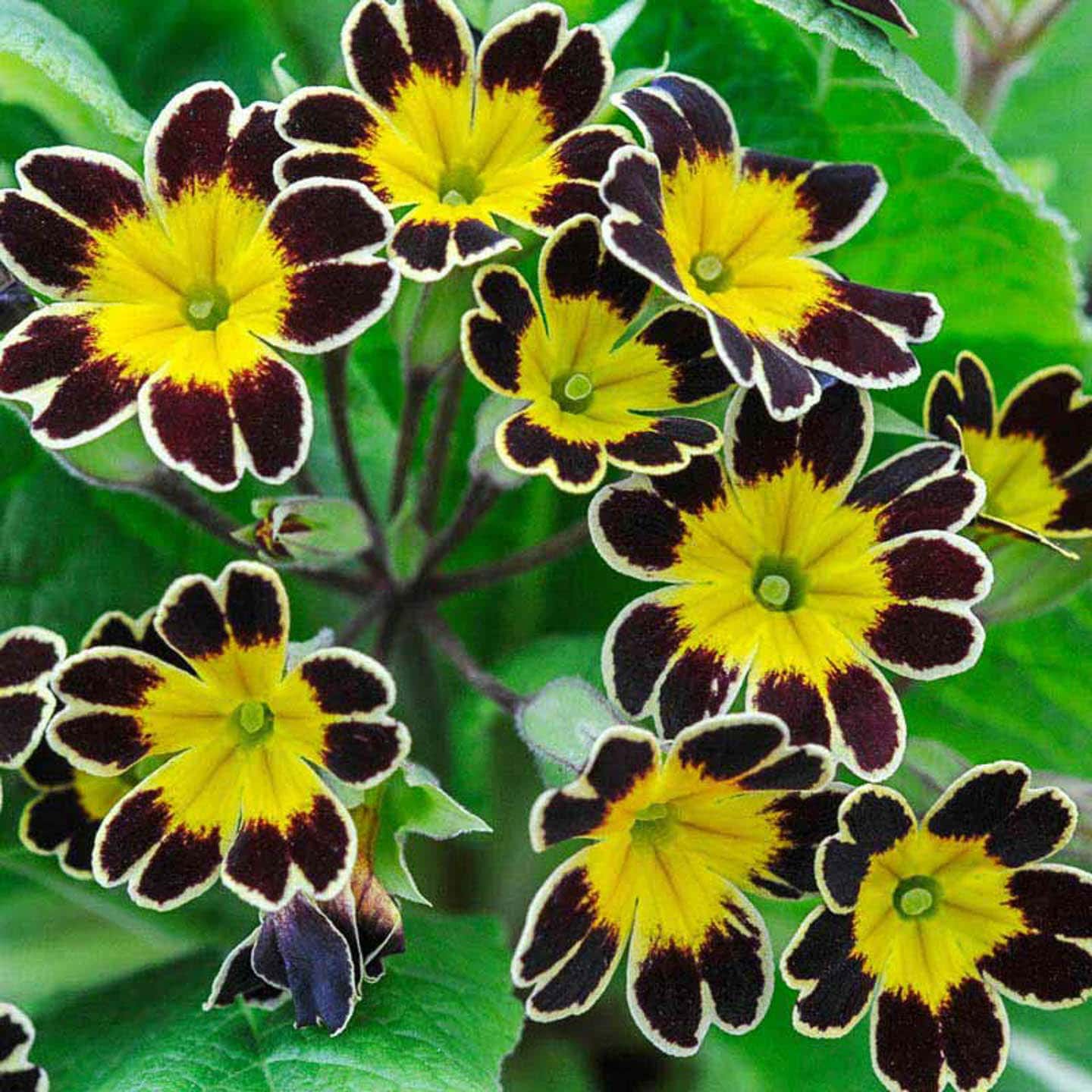
Scientific name: Primula vulgaris ‘bumble bee’
Zone: 3 – 8
Exposure: part shade
Height: 6″ – 8″
Width: 6″ – 12″
Bloom time: early spring
Flower color: yellow with black trim
‘Bumble bee’ is an easy to grow plant, great for beginners to try, and also mildly fragrant.
Situate 6″ to 12″ apart, in slightly acidic, humus-rich soil in partial shade.
This perennial needs consistent moisture, so does well in a woodland setting.
Mulch annually and propagate by division every 3 to 4 years immediately after blooms are finished.
8 | Pansy
Pansies are a cool weather plant that are very easy to grow.
While many pansies are technically perennials, they are short-lived and may not survive hot summers.
So I treat them as annuals to bridge the gap between the early flowering bulbs and the planting of annuals.
Here are a couple of my favorite yellow varieties.
a) Yellow blotch pansy
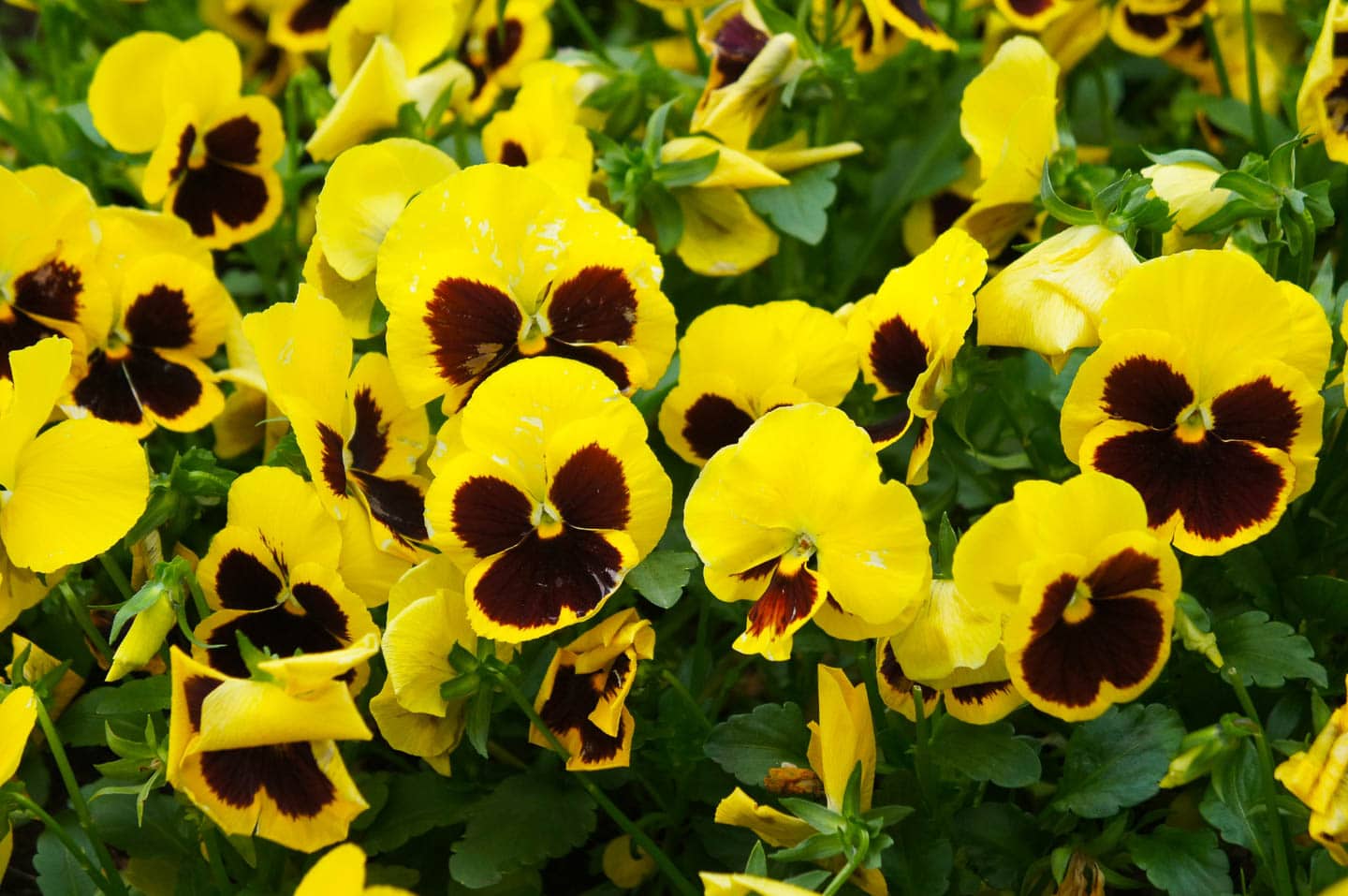
Scientific name: Viola x wittrockiana ‘Yellow Blotch’
Zone: 7 to 10 over winter well, 4 to 6 will go dormant in the coldest part of winter
Exposure: 6 hrs. of sun daily, with some shade in hot afternoons in warmer zones
Height: 6″ to 8″
Width: 8″ to 10″
Bloom time: spring, autumn, winter
Flower color: bright yellow flowers with a dark central blotch
The Yellow blotch pansy has large, cheerful 3 to 3½” flowers that withstand cold and do better in the heat than many others.
Buy plants with a white, well developed root system, lots of buds, and healthy green leaves. Or grow them from seeds.
Ideally, pansies should be set out when the night temperature is 40 degrees and the days are 60 degrees F.
Plant in slightly acidic soil which has been amended with either slow release fertilizer or manure.
Regular dead heading is important to encourage new blossoms. When the plant becomes leggy, cut back by 1/3.
Re fertilize with a low nitrogen fertilizer every 4 weeks and after shearing. Water before fertilizing from the base only.
b) Tiger eye pansy
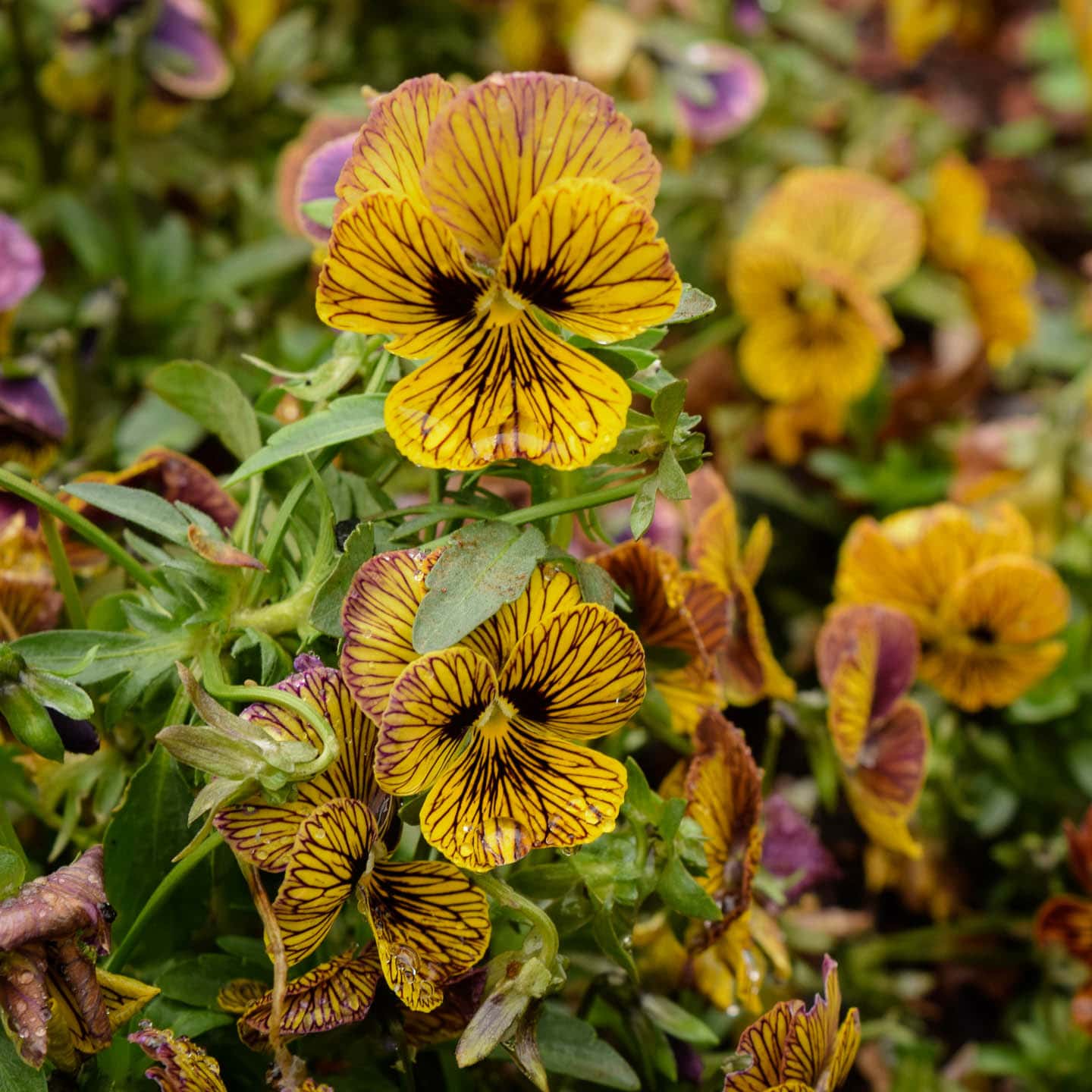
Scientific name: Viola cornuta ‘Tiger eye’
Zone: 4 to 9
Exposure: full sun, part-shade
Height: 6″ to 8″
Width: 6″ to 8″
Bloom time: fall to spring
Flower color: yellow with black stripes
Sorbet tiger eye pansy is a small compact perennial plant with prolific 1″ blossoms on evergreen foliage.
It is cold tolerant and may survive the summer if kept moist and cut back by half in June.
It attracts bees and butterflies and looks good with spring bulbs and planted en masse near the front of the border.
9 | Little Leo Leopard’s Bane
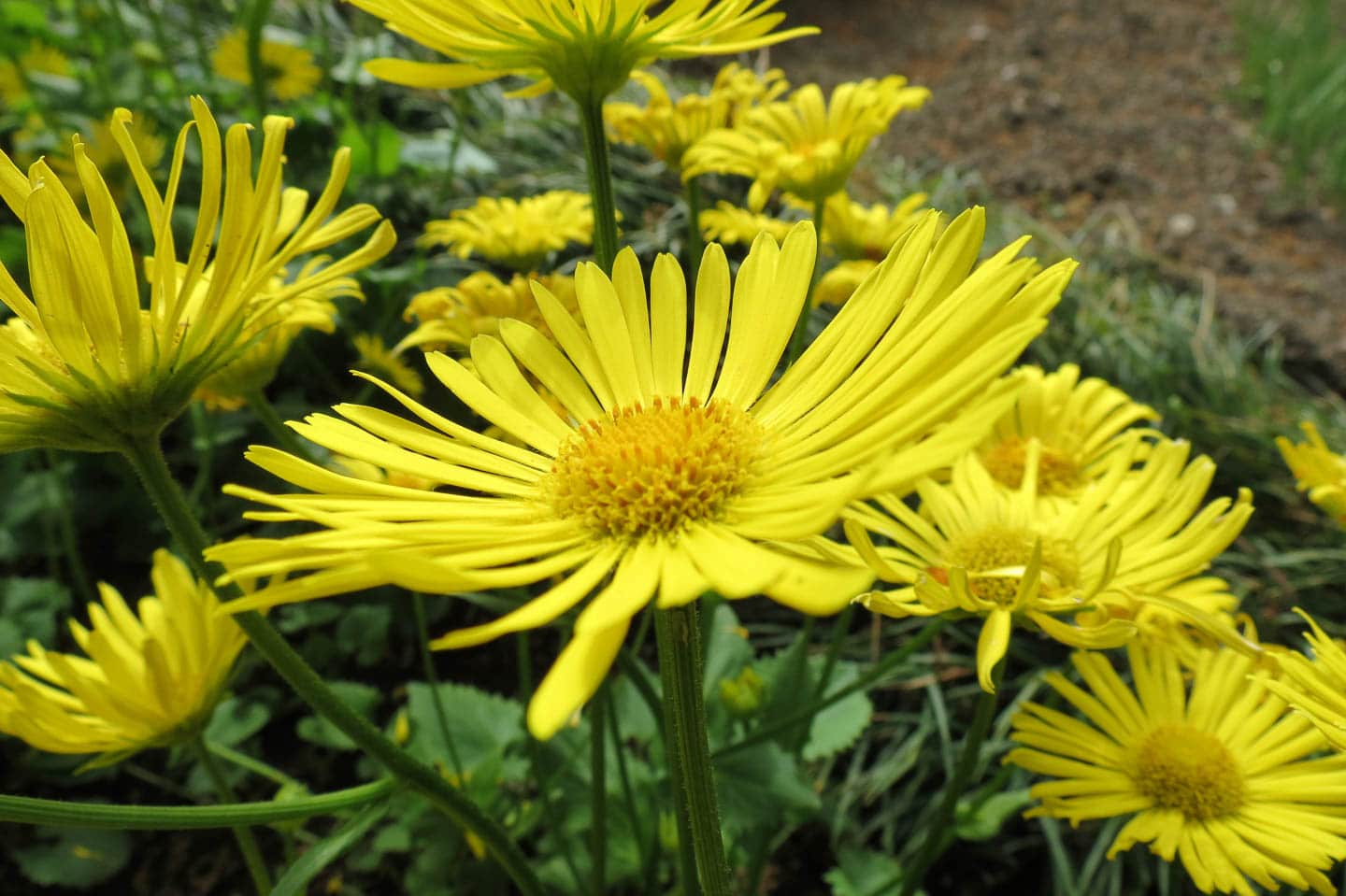
Scientific name: Doronicum orientale ‘Little Leo’
Zone: 3 to 8
Exposure: part shade
Height: 12″
Width: 10″
Bloom time: early spring
Flower color: bright yellow with gold eyes
Little Leo leopard’s bane has 1½” daisy-like semi-double blossoms that bloom before some of the early spring daffodils. And flower for quite some time–about 2 months.
Plant in poor soil in partial shade and give consistent moisture.
Cut spent flowers to prevent self-seeding.
This easy care plant attracts nectar-loving insects and birds, but repels deer and rabbits.
Flowers are lovely in a cut bouquet.
In hot climates, little Leo may go dormant in the summer, otherwise cut it down to the ground in the fall.
10 | Forsythia

Scientific name: Forsythia
Zone: 3b to 8
Exposure: sun
Height: 2′ to 10′
Width: 2′ to 12′
Bloom time: early spring
Flower color: yellow
The bright yellow multitude of flowers covering the bare stems of the forsythia bush are well recognized as a sign that winter is over.
They last about 2 weeks before the green leaves emerge.
Forsythia is a low maintenance, easy to grow shrub that should be located in well drained soil and used as a specimen in the garden rather than in formal foundation settings.
It has a dense weeping habit that can be construed as messy.
It blooms on old wood, so should be pruned immediately after blooming. Remove old stems at the base to keep its graceful natural shape. It can be cut down to the ground and will grow back in its proper form.
This plant is relatively disease free. As well, it is deer tolerant and Japanese beetle resistant.
There are many cultivars to choose from that allow the gardener to select the size and cold hardiness appropriate for the specific site. Some examples are:
- ‘Northern sun’ — 10′ tall and 9′ wide very hardy to zone 4
- ‘Sunrise’ — 5′ tall and wide, mounding compact form, mid-sized cultivar
- ‘Golden peep’ — 18″ to 24″ tall and 36″ wide, a compact dwarf
Branches of the forsythia bush are easy to force into bloom indoors. In January or February, cut a few stems, put them in water and they will bloom in 10 days.
11 | Asian Witch Hazel ‘Arnold Promise’
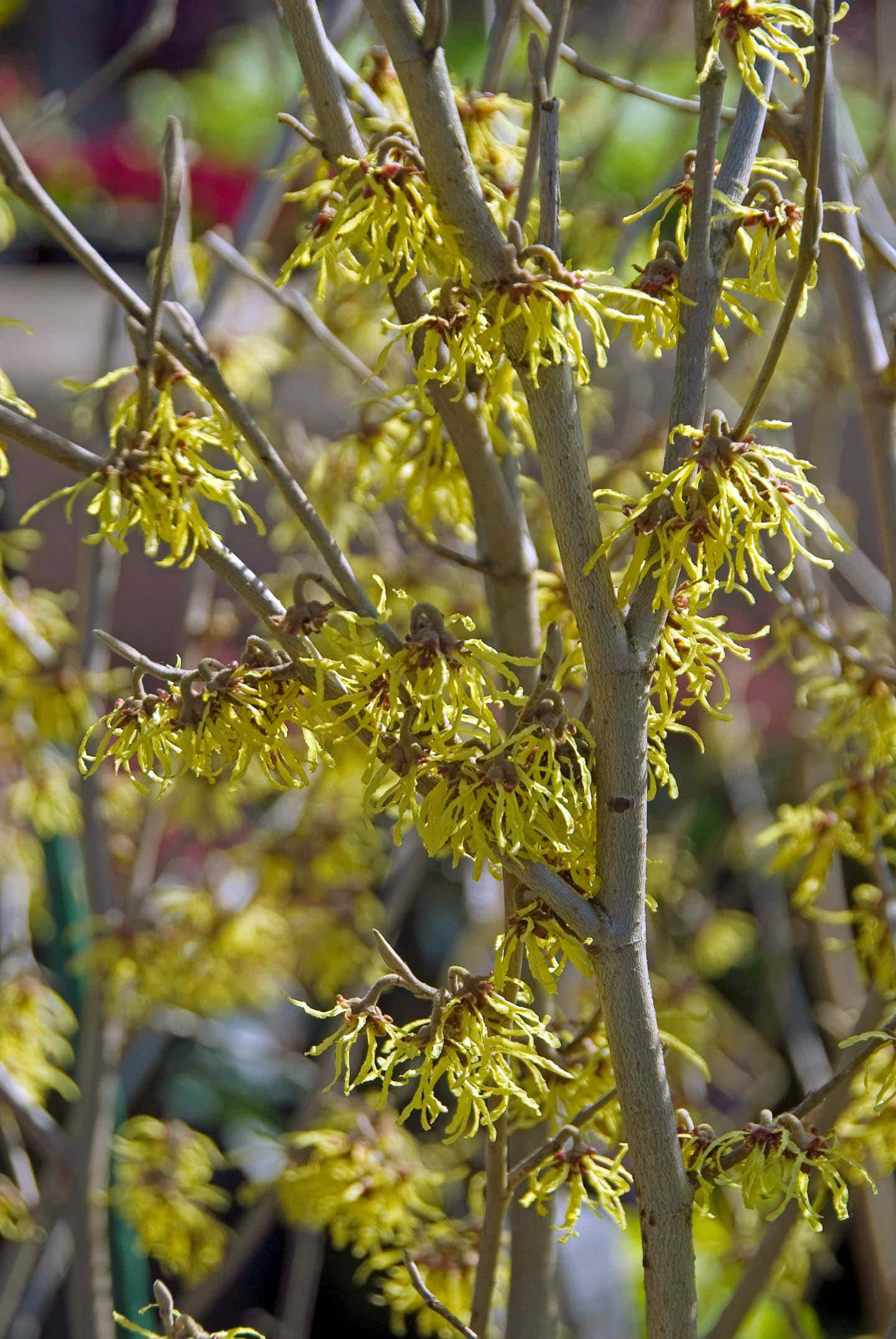
Scientific name: Hamamelis x intermedia ‘Arnold Promise’
Zone: 5 to 8
Exposure: light shade to full sun
Height: 8′ to 12 ‘
Width: 8′ to 12′
Bloom time: late winter, early spring
Flower color: clear yellow with red calyces
‘Arnold Promise’ witch hazel is a deciduous Chinese/Japanese hybrid shrub that has beautiful yellow late winter flowers and a very pleasant fragrance that fills the early spring air. They also have lovely summer foliage and great fall color.
These bushes bloom earlier than forsythias and have been underutilized in the landscape, considering their four season interest and how easy and low maintenance they are to grow.
Plant in moist well drained, slightly acidic soil.
They are somewhat drought tolerant once established.
Witch hazels do well as the second story under tall trees.
They occasionally need pruning to limb-up so that they can be underplanted.
Suckers will grow from below the graft and should be removed.
This plant is mainly pest and disease free.
12 | Azalea
Azaleas are a beautiful spring shrub that aren’t usually known for yellow flowers.
But there are a couple of early spring varieties that can add that bright pop of color to your garden.
a) ‘Lemon Lights’ Azalea
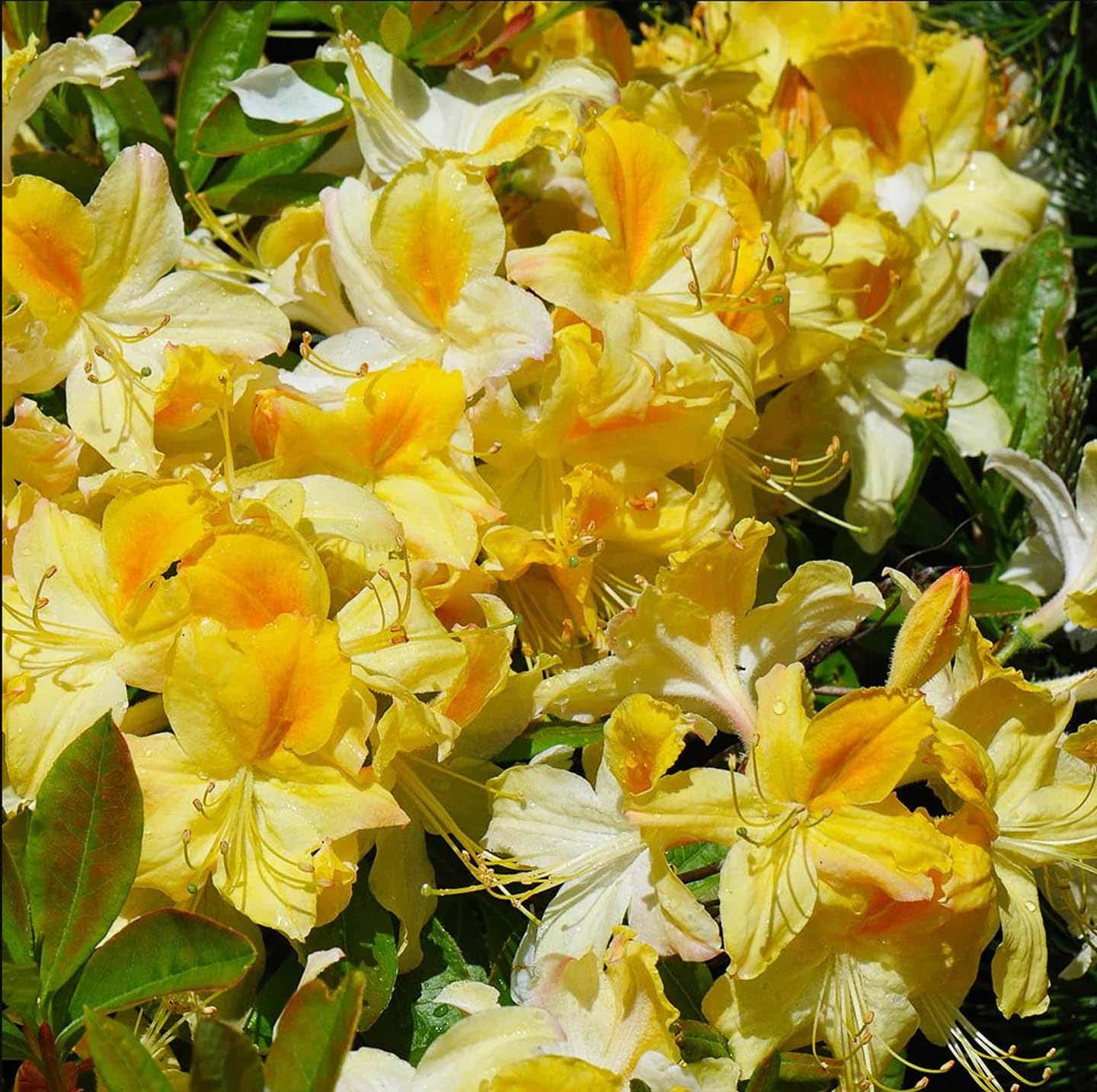
Scientific name: Rhododendron ‘Lemon Lights’
Zone: 4 to 9
Exposure: full sun, part sun
Height: 4′ to 5′
Width: 4′ to 5′
Bloom time: early spring
Flower color: yellow
‘Lemon lights’ azalea is a hardy shrub that has large yellow funnel-shaped blooms in varying shades of yellow.
This is another cultivar of the Northern Light series developed by the University of Minnesota for its cold tolerance.
Plant in well draining, humous rich, acidic soil and water in well.
Apply 2 inches of acidic mulch 2 inches away from the stems annually. As well, feed an acid fertilizer in the spring if your soil is not normally acidic.
I only prune azaleas to remove stray branches and broken or dead wood. They bloom on old wood so should be pruned immediately after the flowers die.
b) Admiral Semmes Native Azalea
Scientific name: Rhododendron ‘Admiral Semmes’ (North American Native Plant)
Zone: 5 to 9
Exposure: shade, dappled shade, morning sun with afternoon shade
Height: 5′ to 6′
Width: 4′ to 5′
Bloom time: early spring
Flower color: bright yellow
‘Admiral Semmes” is a tough north American native that is easy to grow and maintain.
The medium-sized, trumpet-shaped, single yellow blossoms are very fragrant.
They appear before the medium green deciduous foliage in early spring.
It is not recommended to use this bush as a hedge. The plants should be placed 10′ apart as a specimen in a shady location.
Humous-rich acidic well drained soil is ideal. It needs average moisture until established.
This 2007 Georgia Gold Metal Award winner is exceedingly heat and humidity tolerant. It attracts pollinators but is disease resistant.
This deciduous shrub’s glossy dark green leaves turn orange-bronze in the fall.
13 | Japanese Rose
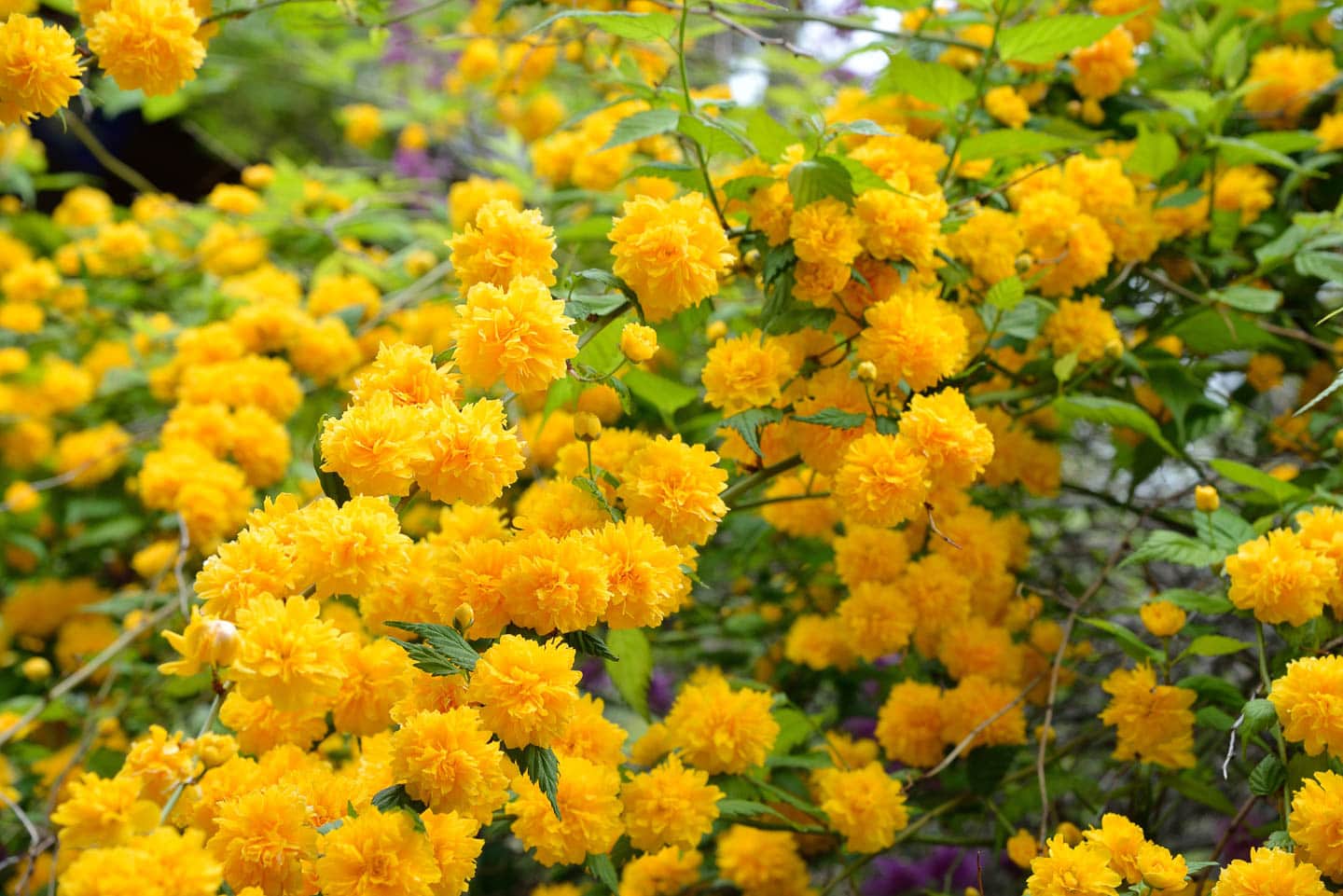
Scientific name: Kerria japonica
Zone: 4 to 9
Exposure: shade
Height: 3′ to 7′
Width: 6′ to 9′
Bloom time: spring
Flower color: bright yellow
Kerria is a deciduous shrub with green cane-like stems and yellow flowers on the terminal ends of the stems.
Depending on the cultivar, the 1″ to 2″ flowers are 5 petalled or round balled doubles (K. Japonica ‘plentiflora’). My ‘plentiflora’ reblooms later in the summer with fewer flowers than the spring showing. The leaves are long and slender — birch like.
Japanese rose tends to get leggy and it also suckers so be prepared to prune back hard after the blooms fade. To prevent the shrub from spreading, cut the suckers at the ground as they emerge.
Plant Kerria in well drained, medium fertile soil as a specimen in the shade garden.
It will attract butterflies and hummingbirds but not deer. It is drought tolerant and disease resistant.
14 | Winter jasmine
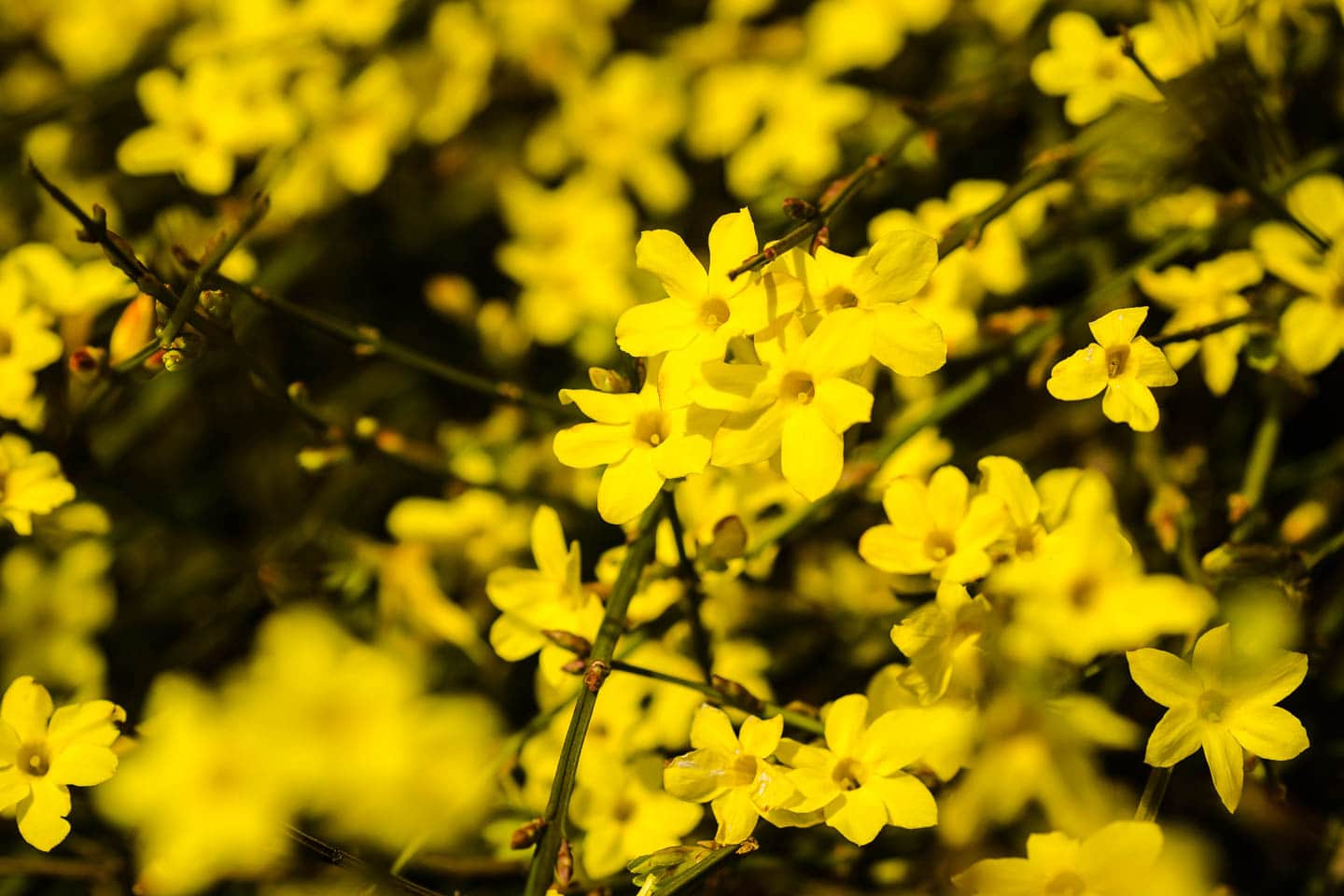
Scientific name: Jasminum nudiflorum
Zone: 6 to 9
Exposure: sun, part shade
Height: 4′ if grown as a shrub, 10′ to 15′ if grown as a vine
Width: 7′ as a shrub, 3′ to 6′ if grown as a vine
Bloom time: late winter
Flower color: yellow
Winter jasmine is an arching viney deciduous shrub that grows from a central crown.
It will form a sprawling mound and spread by rooting wherever the branches touch the ground. This feature is advantageous for erosion control on a slope (but can spread rapidly in the garden).
It is best sited against a south wall on a sturdy trellis where it grows as a vine.
It is also spectacular cascading from the top of retaining walls.
The non fragrant, 1″ yellow flowers, which appear a month before forsythia blooms, precede its oval dark green leaves along the green stems.
This low maintenance shrub is not fussy about soil except it does not tolerate heavy clay.
It should be pruned immediately after flowers fade.
To rejuvenate, cut back to 18″ from the ground.
A winner of the Award of Merit from the Royal Horticultural society, winter jasmine is a pest and disease free plant that is deer resistant and drought tolerant.
Other early spring plants you might like
Have comments, questions or suggestions for early spring yellow flowers? Tell us in the section below.
This post was originally published on February 15, 2023 but was updated with new content on September 12, 2023.

